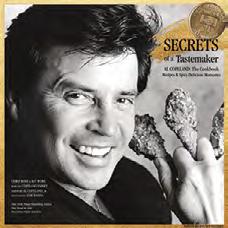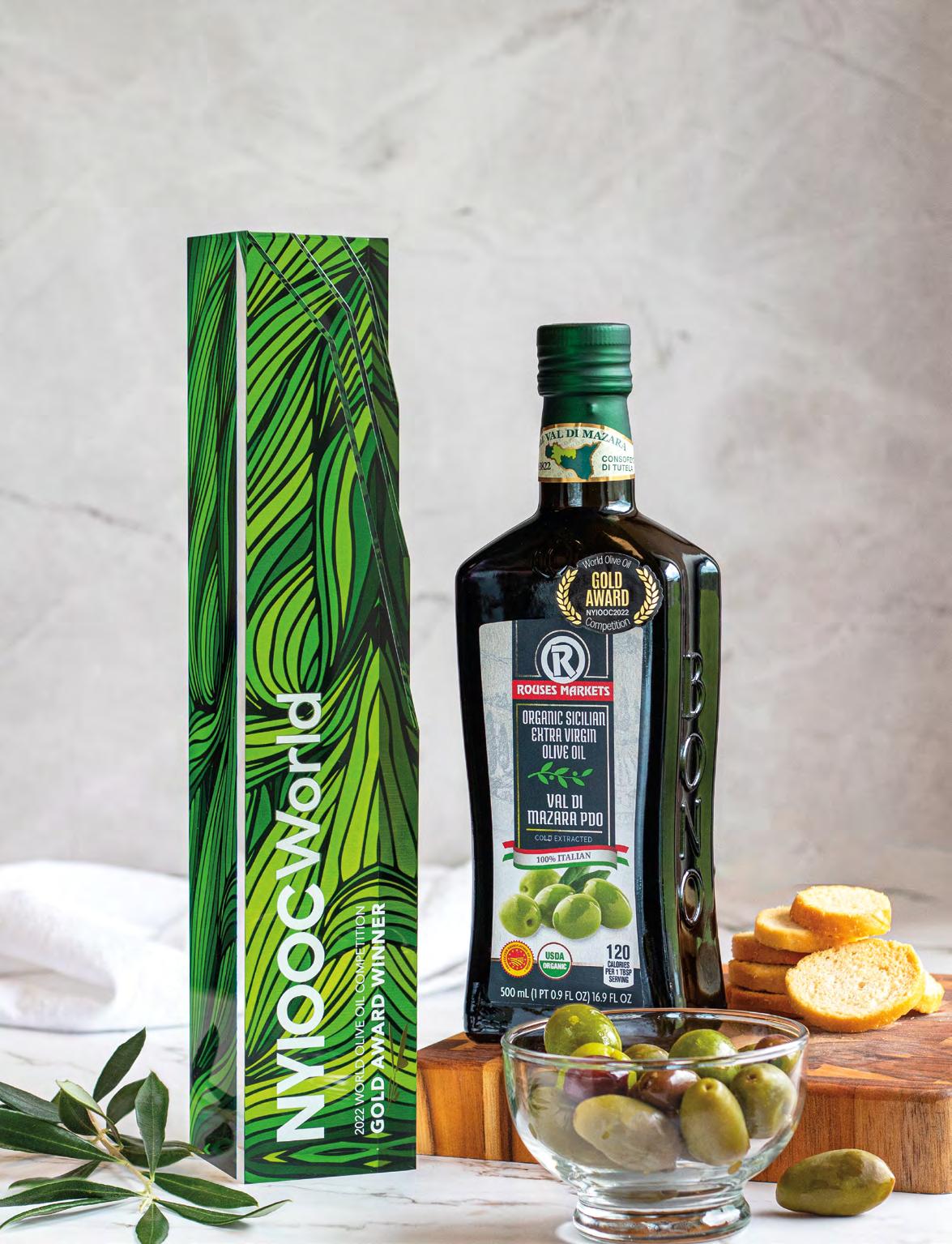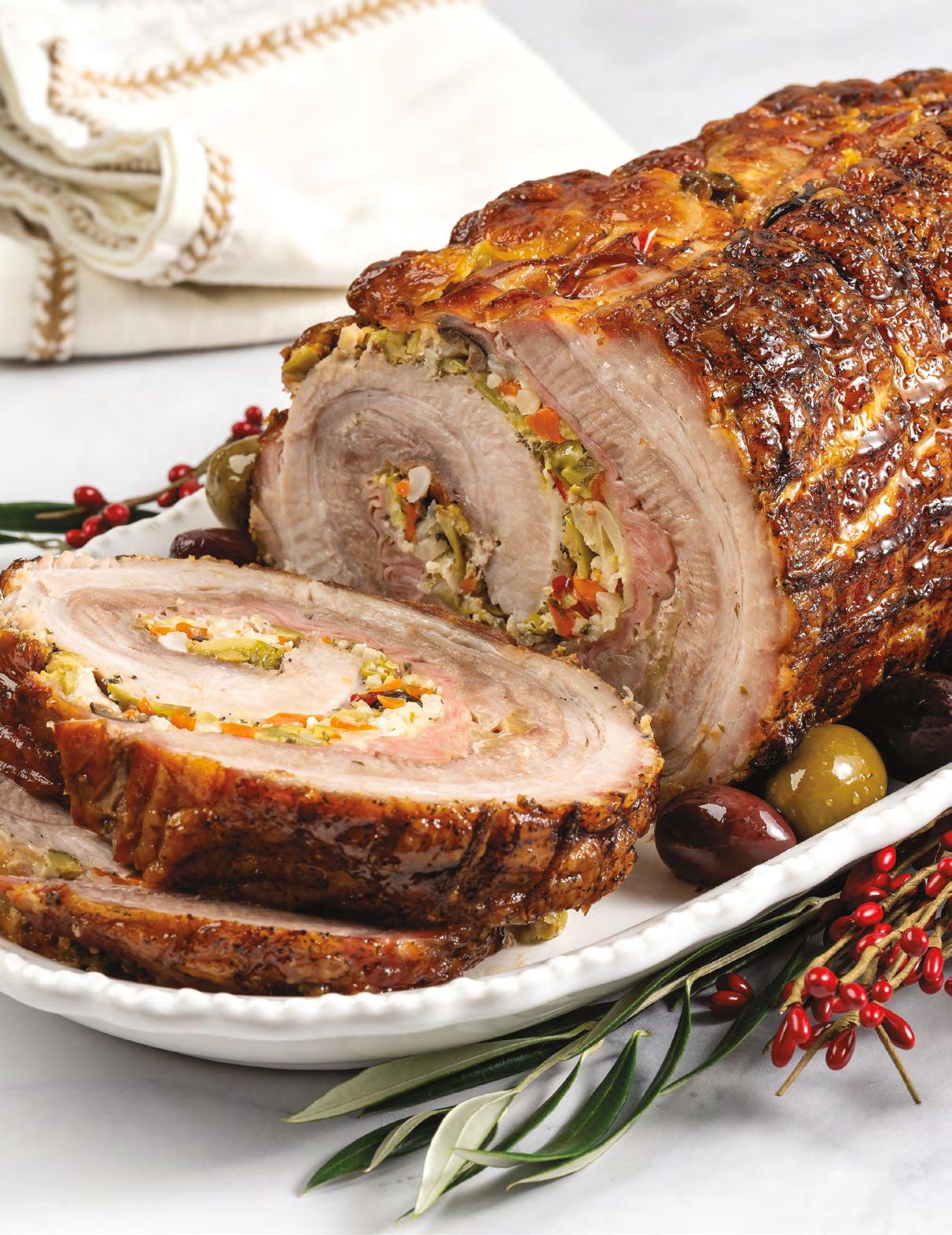





“IF OUR NAME IS ON THE LABEL, YOU CAN TRUST IT’S GOOD.”




 - Donny Rouse, CEO
- Donny Rouse, CEO











 - Donny Rouse, CEO
- Donny Rouse, CEO
Feeding the hungry has always been our number-one giving priority — and not just during the holidays. With the generous participation of our customers and supplier partners, we have been able to provide almost 3 million meals to help feed and support our neighbors in need over the past 12 months.
In November we kick off a new initiative with the New Orleans Saints. Tackle Hunger will help provide food directly to our neighbors in need. The food and funds raised will also go a long way to replenish our local food banks, which are still stretched thin from the pandemic, Hurricane Ida and other storms in recent years.

Our local food banks don’t just collect and distribute food. Second Harvest, the Greater Baton Rouge Food Bank, Feeding the Gulf Coast and others run vital programs, including senior programs, mobile food banks and the backpack program to reduce child hunger. They help supply our local food pantries, school pantries and community kitchens, as well as provide emergency food box deliveries.
Next time you visit a Rouses Markets, look for the collection bins in the front of the store. We accept nonperishable food and household supplies year-round. You can also donate cash at checkouts at any Rouses Market, with 100% of the proceeds going to our local food banks.
Tackle Hunger is one example of why the Saints’ partnership with Rouses Markets continues to leave a lasting impact in our community, and I am excited to see the difference we make by providing food to those in need.
— Gayle Benson, New Orleans Saints OwnerEnough for more than 3 million meals donated.
We proudly partner with hundreds of organizations throughout the Gulf Coast, providing cash, food and water. These are nonprofit organizations large and small, as well as schools and religious institutions working to make the communities we share better places to live and work.
We sponsor and participate in festivals and community events across the Gulf Coast.
The Saints aren’t the only team we sponsor. We sponsor schools, teams and clubs all over the Gulf Coast.
Through our annual pin-up campaigns, together we contributed more than $65,000 to causes and nonprofit organizations this year.
Through our Disaster Relief Fund, and with the support of our vendor partners, over the past 14 months, we have distributed more than $200,000 to our team members who suffered devastating losses to their homes and personal belongings due to Hurricane Ida and other natural disasters.
We are committed to supporting students planning careers in the grocery business. The Anthony J. Rouse, Sr., Food Entrepreneurship Scholarship, named after our founder (my grandfather), is given to an employee attending the John Folse Culinary Institute at Nicholls State University. The Leroy Theriot Meat & Charcuterie Culinary Arts Scholarship at the John Folse Culinary Institute at Nicholls State University helps aspiring culinary and grocery professionals, with the goal of developing the next generation of expert meat science professionals.
Donny Rouse, CEO, 3rd Generation PHOTO BY CHANNING CANDIES
Our Authentic Italian Cookies & Pies are handmade with love in Abruzzo, Italy. Feature them on your Holiday spread, or simply top with a bow for the perfect gift! Find them in our bakery.
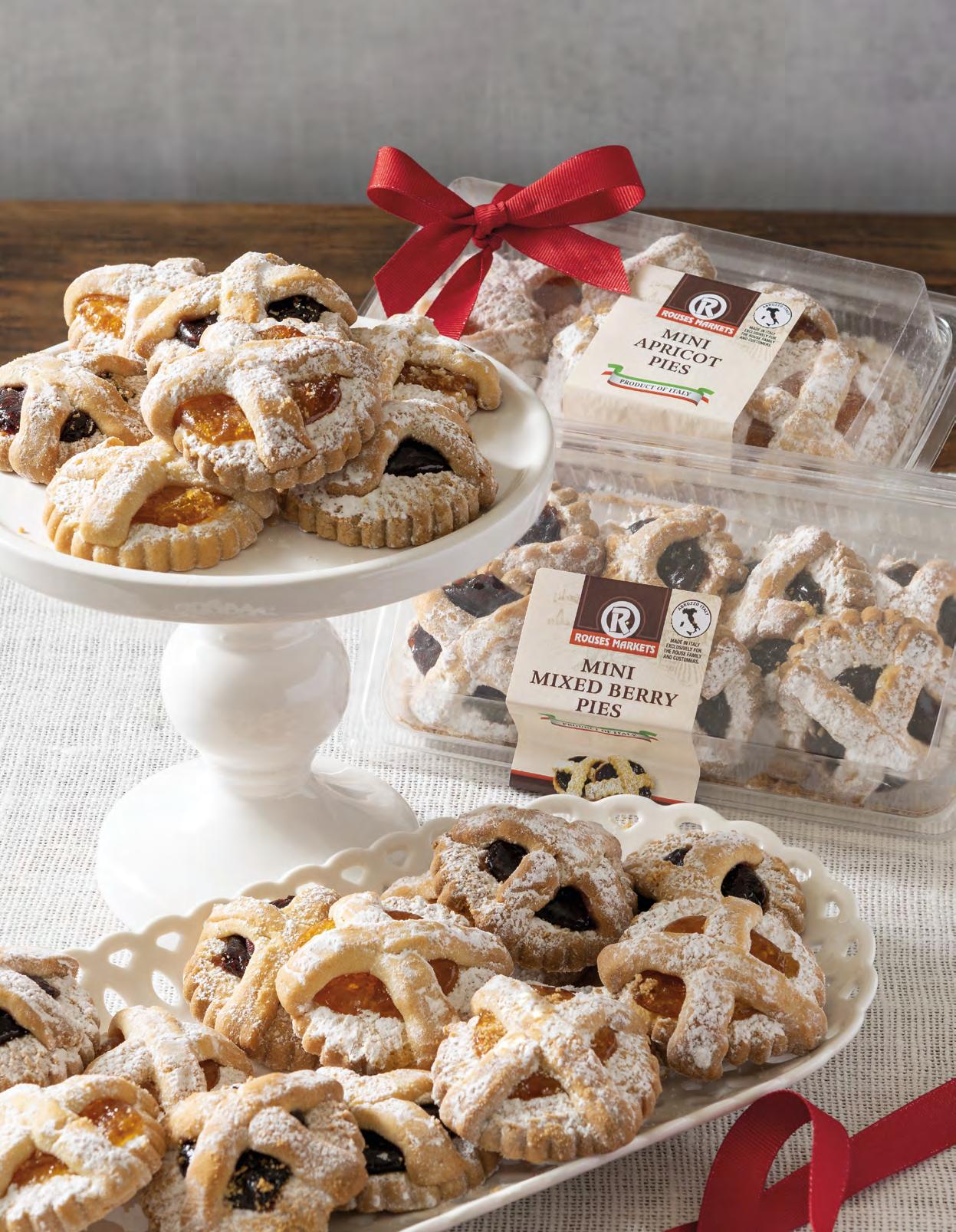
Marketing & Advertising Director
Tim Acosta
Creative Director & Editor
Marcy Nathan
Art Director, Layout & Design
Eliza Schulze
Illustrator
Kacie Galtier
Marketing Coordinator
Harley Breaux
Copy Editors
Patti Stallard
Adrienne Crezo
Advertising & Marketing
Amanda Kennedy
Stephanie Hopkins
Nancy Besson
Taryn Clement
Ann Florey
Intern
Peyton finch
1 Making a Difference in Every Community We Serve by Donny Rouse
5 Letter from the Editor by Marcy Nathan

7
Cookin’ on Hwy. 1 with Tim Acosta
9 Gingerbread Rouse by Ali Rouse Royster

15 Frankly N’Awlins by Sarah Baird
19 Six Degrees of Kevin Belton by Poppy Tooker
21 Hallmark the Herald Angels Sing by David W. Brown
27
Feast Day by Sarah Baird 30 Noche Buena by Sarah Baird
33 Cuba N.O. by Alison Fensterstock
39
Give Yourself a Holiday 47
Laissez Le Cabbage Roll by Poppy Tooker
53 Feeling Cinnamon-tal by David W. Brown 55 Ginger All the Way by Sarah Baird 56
Oma Sweet Oma by David W. Brown 58
Camp Walden by Marcy Nathan 70 2023 Is the Year of the Rabbit by Sarah Baird 74
Lunar New Year: Wishing You Happiness and Prosperity by Sarah Baird
Cure for the Common Cocktail by Wayne Curtis 79
Joy to the Word!
17
Frank Davis’s Franksgiving Turkey Roasted in a Pot
Frank Davis’s Mirliton Casserole 32
Ms. Dora’s Flan Café Cubano 33 Crema de Vie (Cuban Eggnog)
43 Muffaletta Porchetta 44 Glazed Brussel Sprouts with Pancetta 46 Stuffed Cabbage Rolls 47
Aunt Evelyn’s Stuffed Cabbage with Oyster and Cornbread Dressing
Sweet & Sour Stuffed Cabbage Rolls
49
Italian Lentil Soup 58 Schnecken 59 Hanukkah Babka
65
Leftover Turkey Gumbo Gumbo of the Month: November 66 Turkey Stock Fried Turkey Necks
Turduchen Gumbo Gumbo of the Month: December 67
New Year’s Eve BlackEyed Pea Gumbo Gumbo of the Month: January



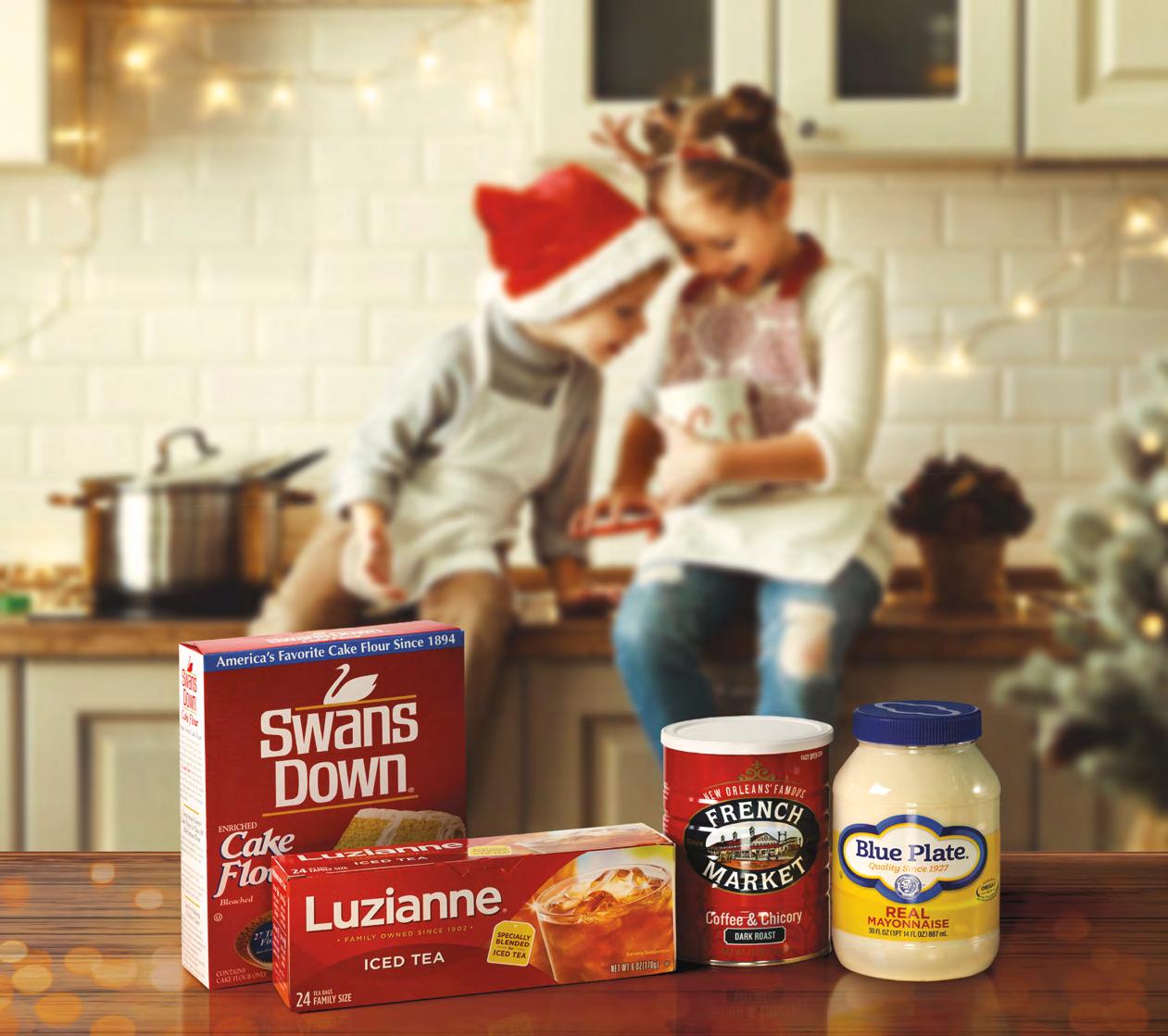

There’s a reason New Orleanians fi nd themselves in the kitchen come holiday time. It’s where our most cherished traditions come to life. And we’re proud to have played a part in the festivities. So to all the cooks, bakers, and chefs whose creations make the holidays taste like home, may the
avors and fun of this season bring you happiness and joy.
The dish on our cover is pronounced pohr-KEHT-tah. I have been mispro nouncing it pohr-CHET-tah, like fuh -GET her. Our marketing and advertising director, Tim Acosta, has given up correcting me. I assumed I was right, and he was wrong, so I ignored him the first 100 times he told me I was wrong. In fairness to me, Tim constantly mispronounces and makes up his own words. Tim once sent me into a store to get a “loge” skillet for a photo shoot. The guy in the hardware store was completely confused until I pointed to a display of brand-new cast-irons. “You mean Lodge?”

Porchettas are usually stuffed with garlic and herbs. For the one gracing our cover, we used our Rouses Italian Olive Salad, which is made with a giardiniera (prounounced jar-deen-YAIR-uh of pickled cauliflower, carrots and celery, to make a modern muffaletta. Or muffuletta. Pronounced muf-fah-letta, moo-fah-letta or muff-a-lotta, depending on where you grew up. We used mortadella, a cured Italian cold cut, but our chef (and store director) Marc Ardoin said you can substitute Chisesi ham. Don’t worry, if you aren’t from here, I don’t expect you to know how to pronounce Chisesi. Here it’s Ch-SAY-see, which is not the same as the Italian pronunciation, kee-SAY-zee.

Last issue, we argued over whether or not you’re allowed to put tomatoes in your gumbo (for the record, we did a poll, and the majority of you thought it was OK; yes, we were surprised).

This issue, it was over how to pronounce mirliton.
I don’t care if you say MUR-li-ton or MEERlee-tawn or MEL-lee-tawn, or if you stuff it or
make a casserole out of it. Honestly, I swap back and forth between pronun ciations and preparations. And it’s OK by me if you confuse a sweet potato for a yam, or vice versa, even though they are different root vegetables.
But I draw the line at PEE-can. A PEE can is a port-a-let. It’s where you pee on Mardi Gras Day (if you can find a place to pee on Mardi Gras Day). It’s pronounced peek-KAHN or pick-AHN. Like gone pecan.

People who say PEE-can live on the East Coast and call New Orleans, N’Awlins. (Only Frank Davis was allowed to do that without sounding like a tourist.) For the record, I say New OR-lins. But my favorite pronunciation is New AHL-lee-ins.
It’s a given that if you say PEE-can, you probably say PRAY-leen or PRAY-line instead of PRAAH-leen…or maybe you are just from Georgia.
At Rouses, we spell turduchen with an h, for hen. But other places spell it turducken with a k for duck, and no h. Let them have their spelling. Their turducken doesn’t taste as good as ours. But then, we’ve been making our turduchens a lot longer. We also make a fresh turduchen sausage. And for our Year of Gumbo that we’re observing, we have a recipe for a turduchen Christmas gumbo you can make at home (see page 66).

And in the end, just because you say toe-MAY-toe, and I say toe-MAH-toe, there’s no reason to call off the holidays. Unless those tomatoes are in my gumbo.

ARROW-CIRCLE-RIGHT I wrote about schnecken—the word means snail in German—for our section on cinnamon. These sticky sweet rolls are made with cinnamon, brown sugar, raisins, pecans and so much butter. For the record, it’s pronounced shnek-uhn. See page 58.
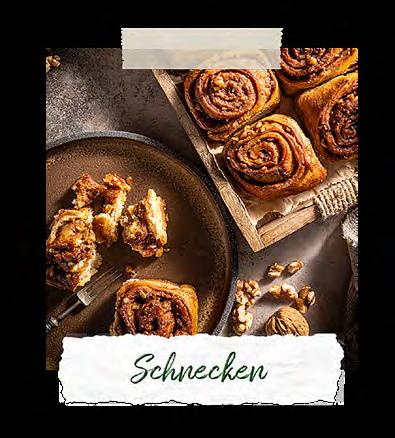
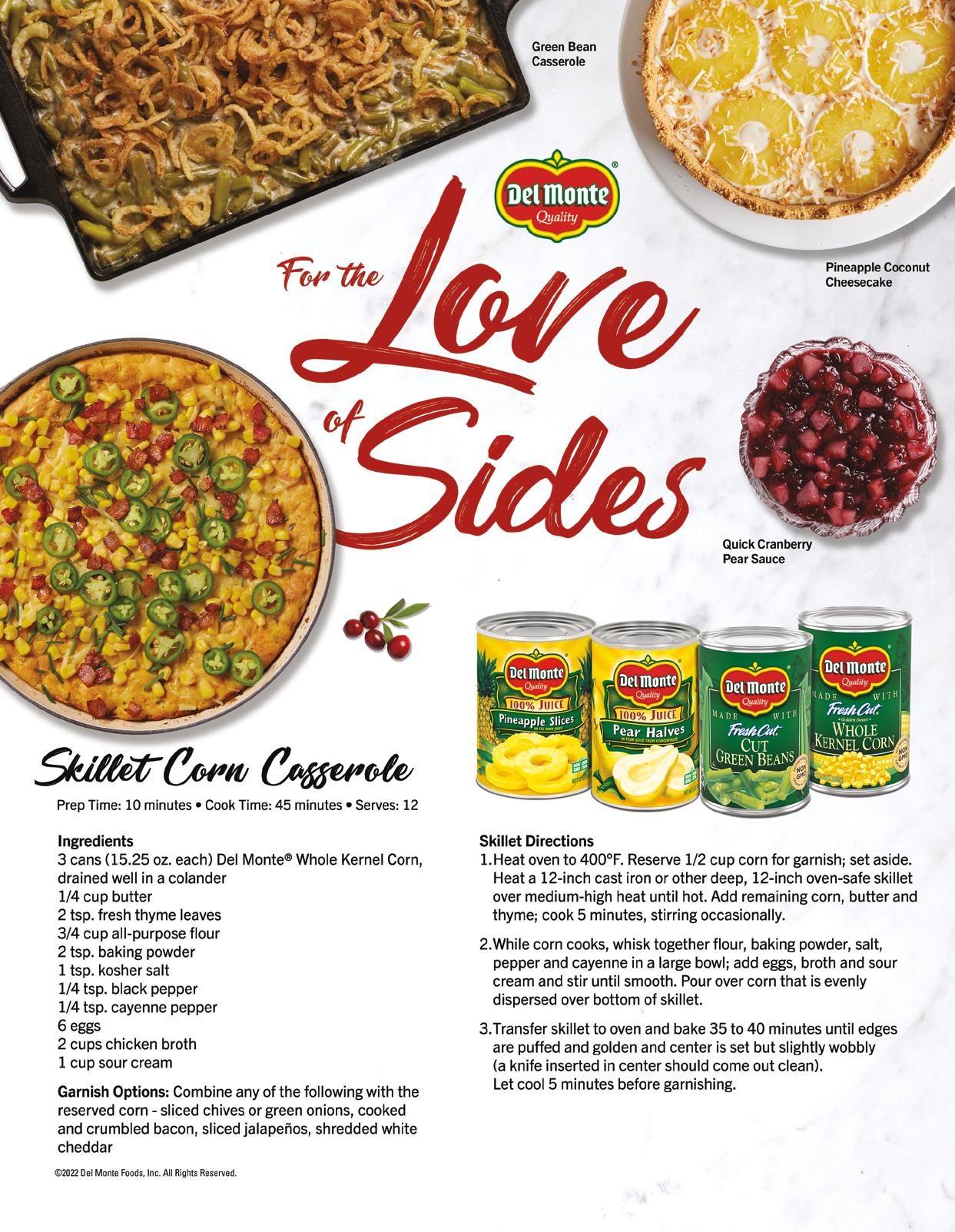
Pecans are everywhere during the holidays, including my own backyard.
There is a wild pecan tree right next to our house that was here when we built. It is about 70 feet tall, with a trunk about four feet around, which means it is at least 80 years old, possibly 85. There is also a small grove of pecan trees in the back behind the cane field that is about 30 years old.
As I write this, the pecans are just beginning to fall. I was surprised to learn that it can take anywhere from seven to 10 years before a pecan tree will produce a bumper crop. After that, the tree can continue to bear pecans for up to 100 years.

I used to be the chief pecan picker-upper at my house, but now I enlist my grandkids to do it. They think gathering them is fun,
especially when they get to use those little rolling nut harvesters to do it. I have a bench with a makeshift nutcracker bolted onto it, and I make good use of it. I crack all of the pecans, or at least par-crack them, so the kids can finish them. It’s like starting a crab.
Pecans are a big part of our holiday cooking. You can’t have a sweet potato casserole without them. My youngest, Cody, and his wife, Vanessa, make a pecan pie for Thanksgiving and Christmas every year. It’s one of my wife Cindy’s favorite holiday desserts. I like it à la mode, with Rouses Vanilla Ice Cream, but it’s delicious enough to eat à la nothing.
I’m not the only pecan grower around here. Pecans are grown all over the South, though commercially they’re mainly in Louisiana, Alabama and Georgia. On average, pecan production adds about $12 million to the Louisiana economy each year, and $10 million to the Alabama economy each year.
About 90% of the pecans we sell at Rouses Markets come from Bergeron Pecans, which is the largest pecan-shelling facility in Louisiana. Bergeron Pecans have been on our shelves since our very first store back in 1960.

Last year, we sold nearly 100,000 packages just for the holidays — I bet we do even more this year.
Bergeron is based in New Roads in Pointe Coupée Parish, which is the top pecanproducing parish in the state. Like so many local businesses, Bergeron started out as something else. Horace Joseph Bergeron was a merchant and a farmer. In 1910, he opened a trading post for locals to come trade or hand-crack pecans in exchange for merchandise and food items. His sons built a pecan-shelling plant next door in 1941, and the family began shelling and packing pecans from farmers all over the state, as well as their own orchards. Today, Bergeron processes 5 million to 7 million pounds of in-shell pecans a year. Like Rouses Markets, Bergeron is led by a third generation of the family, Lester Bergeron. Our produce team works directly with him.
You can use Bergeron Pecans or your own handpicked pecans in my son Cody’s recipe for Pecan Pie.

Makes a 12-inch pie
WHAT YOU WILL NEED:
12-inch premade pie crust
1 cup granulated sugar
3 tablespoons brown sugar
½ teaspoon salt
1 cup dark corn syrup
¹⁄₃ cup melted salted butter
1 teaspoon vanilla
3 whole eggs, beaten
1 cup chopped pecans
¼ cup pecan halves
HOW TO PREP:
Preheat the oven to 350°F.
Blend the granulated sugar, brown sugar, salt, corn syrup, butter, vanilla and eggs together in a bowl until smooth; set aside.
Pour the chopped pecans in the bottom of the unbaked pie shell. Pour the syrup mixture over the chopped pecans. Scatter pecan halves on top, and carefully cover with a piece of foil.
Place pie in preheated oven and bake for 30 minutes. Remove the foil, then continue baking for 20 minutes more, checking frequently to make sure the crust and/or pecans are not burning. Pie should be nicely browned and firm at edges, but still a little liquidy at the center. If the pie still hasn’t set, cover with foil and bake for an additional 20 minute, or until set.
Remove the pie from the oven and let cool for several hours or overnight. Pecan pies should not be eaten hot or warm.














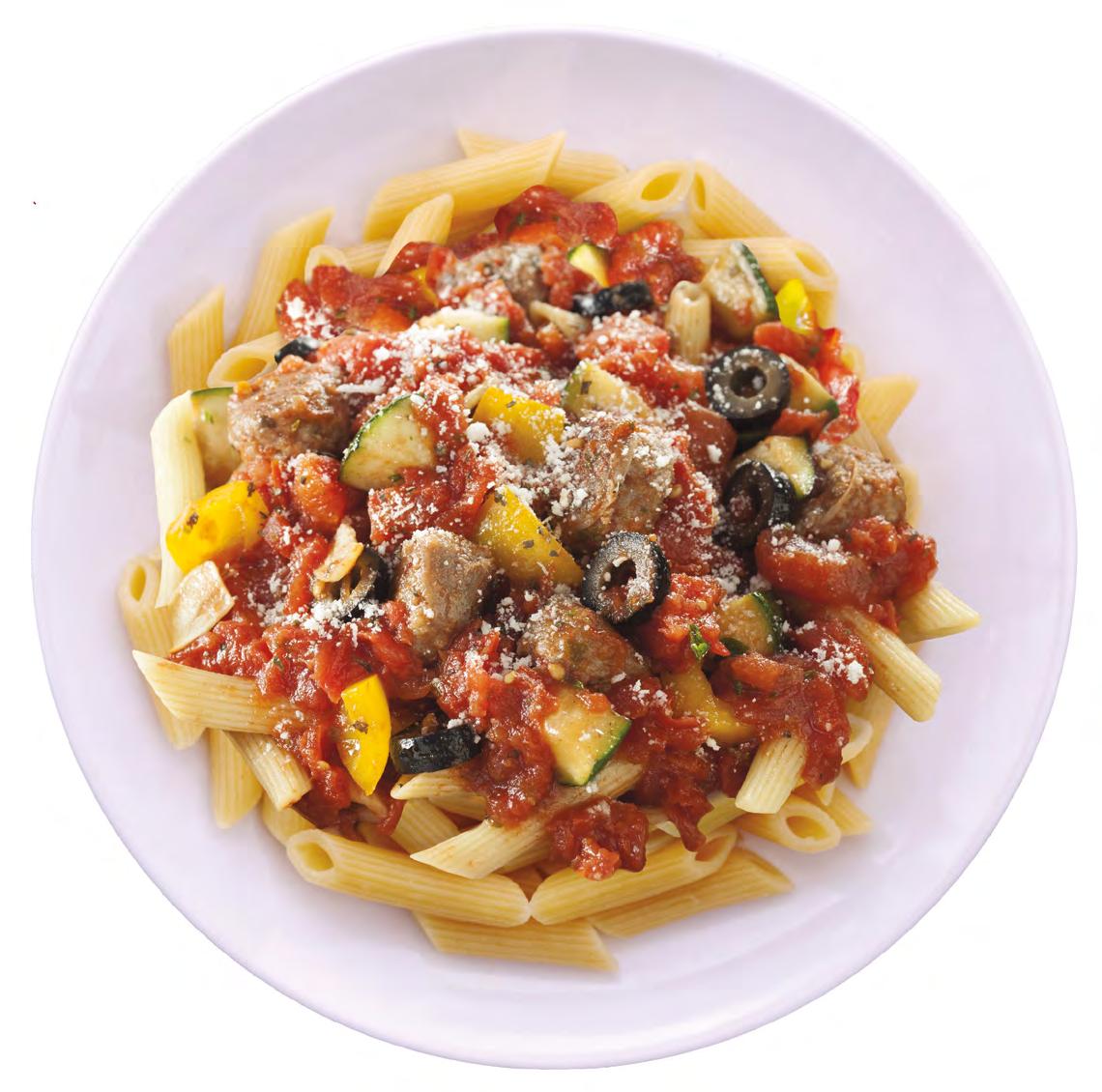

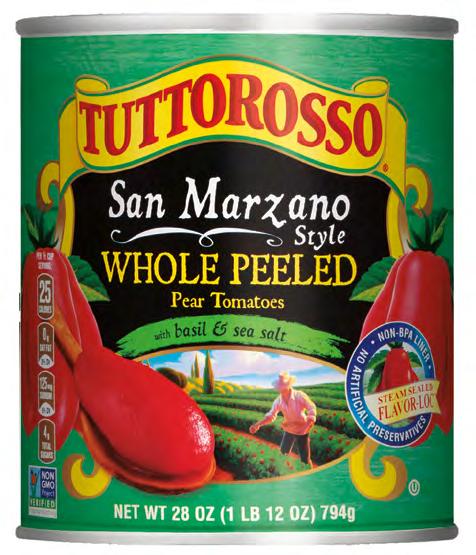


 By Ali Rouse Royster, 3rd Generation
By Ali Rouse Royster, 3rd Generation








At the risk of being labeled a Grinch or a Scrooge, I have a Christmas confession to make: Gingerbread houses are a pain in the rear. There. I said it. They never turn out as nicely as we think they will, and the time and effort it takes is nowhere near worth the resulting sloppy-looking, no-one-wants-to-eat-that-now candy cottage. Despite all this, my parents (God bless ’em) have taken on an annual gingerbread house-building afternoon with their six grandchil dren, who, this year, are ages 5-10. They started with just two grandkids, and that was all well and good, but like the children, it has grown in both number and intensity. Each year, my mom proclaims that Kiki now has the secret to making gingerbread houses better and more smoothly. Once, it was buying supplemental candy to put out to snack on so that you wouldn’t eat all of your decorating candy. Then, there was the year that we made our own royal icing (10/10 do not recommend).

My personal fave was the time I walked into my parents’ house the night before gingerbread house day to find my mom and dad all alone, hard at work pre-building the house structures so none of the kids would have to restrain themselves from touching the houses while they were drying. No matter the process change, the houses still turn out looking like elementary schoolchildren built and decorated them — which of course they did. But no matter what, the kiddos always look forward to their annual afternoon at Kiki and Papa’s to design the gingerbread house of their dreams!

Some of my favorite things about the holiday season are the traditions and my Christmas Eve birthday celebration with family. My mom’s side of the family kicks off the Christmas holiday with a gift exchange (we pull names on Thanksgiving Day) and then a get-together at my grandma’s house on Christmas Eve. Christmas Eve also happens to be my birthday, and my family always finds a way to celebrate me during the Christmas Eve party with a cake, balloons or a toast — and, of course, a happy birthday song. The older I get, the more I realize how special it is to have a birthday on Christmas Eve. My birthday is never just another day, it’s always a celebration, and I’m always surrounded by family.
 – Amanda Kennedy, Senior Manager Brand & Marketing Strategy
– Amanda Kennedy, Senior Manager Brand & Marketing Strategy
Two words: Rice & gravy. I’d never indulged in this delicacy before getting married, as our family stuck to the traditional turkey, ham and sides. When I moved to Chackbay, Louisiana, I was introduced to from-scratch gravy by my husband’s Grandma Carol, and the rest is history. For the past 16 years my entire plate has been filled with rice & gravy, with a second plate of all of the other delicious food that started cooking before sunrise.
– Taryn Clement, E-commerce Manager


Despite our Italian background, over the years my family picked up some pieces from other places. Every year, my sister Cecilia and I receive a German smoker. It’s a little wooden man dressed for various occupations, and he holds a little pipe. You place a lit incense cone inside and the little guy looks like he’s smoking through his pipe! My sister likes to light them all at once so the living room is thick with scented fog. Another Christmas staple in our household is a chocolate orange from the U.K. It’s an orange-flavored and -shaped chocolate sphere wrapped in shiny orange foil. You whack the chocolate orange on the table before unwrapping it. This causes the orange to break into perfect slices.
– Mary Ann Florey, Graphic Designer

Every Christmas we do a movie marathon. We pick a series or an actor, and we spend the whole day in our PJs watching movies. Our favorites are the Die Hard and Lethal Weapon series; we’ve also done all the Marvel X-Men movies and all of Marvel’s The Avengers movies.
– Stephanie Hopkins, Senior Graphic Designer

It’s the most wonderful time of the year, and that means it’s also time for christmas cookies! The holiday issue of our magazine is always my favorite each year, so it’s only fitting that I talk about my favorite holiday tradition in its pages.

My favorite holiday tradition is when my mom, sister, uncle, his girlfriend and I help my Maw Maw Beulah make her famous oldfashioned Christmas tea cookies every December. We have been doing this for as long as I can remember, and each year we easily make anywhere from 500 to 1,000 cookies in a weekend. The process usually takes one or two days, and we make everything from scratch. The recipe is a family secret — I hope to pass it along to my son in the future. We start by making the dough, then we roll it out to cut all the Christmas shapes. The cookies go into the oven for about 8 minutes, and then must dry for a few hours before frosting. Once we have rolled out all the dough and are done baking, we make a bunch of different colors of frosting for decorating. We spend a few hours frosting and decorating all the cookies, then leave them to dry overnight. The next day we make sure everything is completely dry and start putting together containers to give out. Everyone in the family lines up to get their container of cookies each year, and we honestly care more about the cookies than the presents. I love eating mine with a cup of coffee — another little tradition I enjoy right up until Christmas, since these cookies have a

My mom got a recipe for candied pecans from her mother-in-law when she was first married. Every Christmas the sight of these pecans was met with both joy and dread. Joy, because the sheer pleasure of eating these is indescribable. Dread, because once you start eating them, you just can’t stop. Lucky for us, she only made them at Christmas so we were able to rationalize eating as much as we wanted, knowing it would be a whole year before we had them again.
– Nancy Besson, Graphic Designer

One of my favorite holiday traditions is having a family meal on Christmas Day with my dad’s side of the family. My Maw Maw always makes a large spread of food including egg rolls, chicken pho, fixings for spring rolls, fried rice and other dishes. The spread is a little different every year, but it always tastes amazing. You can learn more about my Maw Maw’s tradition on page 74.
– Peyton Finch, Design Intern



If you’ve met me, you know that I’m a full-on cat person. My fiancé David is highly allergic to them, but after a few ENT visits he’s now converted into an even more extreme cat person than I am. Every year, we plan out our most eccentric Christmas card, now starring our two cats, Gurl and Chester. We play Christmas tunes, attempt to dress up the cats, fail miserably, and ultimately surrender to our battle wounds. We already have this year’s card planned out (hint: it involves Rouses Milk).
 – Kacie Galtier, Designer & Illustrator
– Kacie Galtier, Designer & Illustrator
My favorite holiday tradition involves getting away from the hustle and bustle of the city. We grew up camping each summer on the Buffalo River in Arkansas, and it’s still one of my favorite places. We’ve transitioned that tradition to Thanksgiving; we rent cabins in the park (because brr!) and spend the week on the river, walking the winding banks, collecting rocks and enjoying the peaceful getaway.
– Eliza Schulze, Art DirectorSarah Baird is the author of multiple books, including New Orleans Cocktails and Flask, which was released in summer 2019. A 2019 Knight Visiting Nieman Fellow at Harvard University, her work has been featured in The New York Times, Washington Post, Saveur, Eater, Food & Wine and The Guardian, among others. Previously, she served as restaurant critic for the New Orleans alt-weekly, Gambit Weekly, where she won Critic of the Year in 2015 for her dining reviews.
David W. Brown is a freelance writer whose work appears in The Atlantic, The New York Times, Scientific American and The New Yorker His most recent book, The Mission: A True Story, a rollicking adventure about a motley band of explorers on a quest to find oceans on Europa, is in bookstores now. Brown lives in New Orleans.
Wayne Curtis is the author of And a Bottle of Rum: A History of the New World in Ten Cocktails, which was updated and re-released in 2018. He’s written frequently about cocktails, spirits, travel, and history for many publications, including The Atlantic, The New York Times, enRoute, The Wall Street Journal, The Daily Beast, and Garden & Gun He lives in New Orleans.
Alison Fensterstock is a former music writer for the The Times-Picayune in New Orleans and a columnist for the Louisiana Endowment for the Humanities magazine, 64 Parishes. Her work has also appeared in Rolling Stone, NPR Music, MOJO and The New York Times


Susan Langenhennig Granger is editor of Preservation in Print magazine and director of communications and marketing for the Preservation Resource Center in New Orleans. Prior to that she was a news editor, reporter and feature columnist for The Times-Picayune and NOLA.com.
Poppy Tooker is a native New Orleanian who has spent her life immersed in the vibrant colors and flavors of her state. Poppy spreads her message statewide and beyond via her NPR-affiliated radio show and podcast, “Louisiana Eats!”









Ask anyone to make a list of renaissance men of the 20th century in New Orleans, and media legend Frank Davis would undoubtedly be near the top of the list. A four-decade fixture on both radio and television for WWL, Frank not only served as a wellspring of, and reflection for, neighborhood culture in the Crescent City on the small screen and airwaves, but worked to redefine how audiences approach recipe development and familiar ingredients in their own kitchen, providing the sort of authentic, familial approach to home cooking in his broadcasts that had yet to be seen locally with his “Naturally N’Awlins!” warmth and innate storytelling abilities.
Oh, and did I mention he was also an avid outdoorsman, tremendous writer, cookbook author, one-time X-ray techni cian and spice-making entrepreneur? And that, after his passing in 2013, he was honored for his foundational place in South Louisiana history when the I-10 Twin Span Bridge that links Orleans Parish and St. Tammany Parish was officially renamed the Frank Davis “Naturally N’Awlins” Memorial Bridge?
Like I said, a true renaissance man.
No matter the medium, whenever Frank Davis shared a recipe, it was like he was chatting with you about it over a cup of coffee, not bringing the idea down from a culinary ivory tower. And no other time of year better reflected his desire to share his collection of classic-but-creative, memorymaking recipes than around the holidays, or as they’re better known among, ahem, Frank-ophiles: Franksgiving and Naturally Noel.
“Frank Davis was the icon at WWL but, every Tuesday morning starting in the 1980s, he would be in the kitchen cooking. At

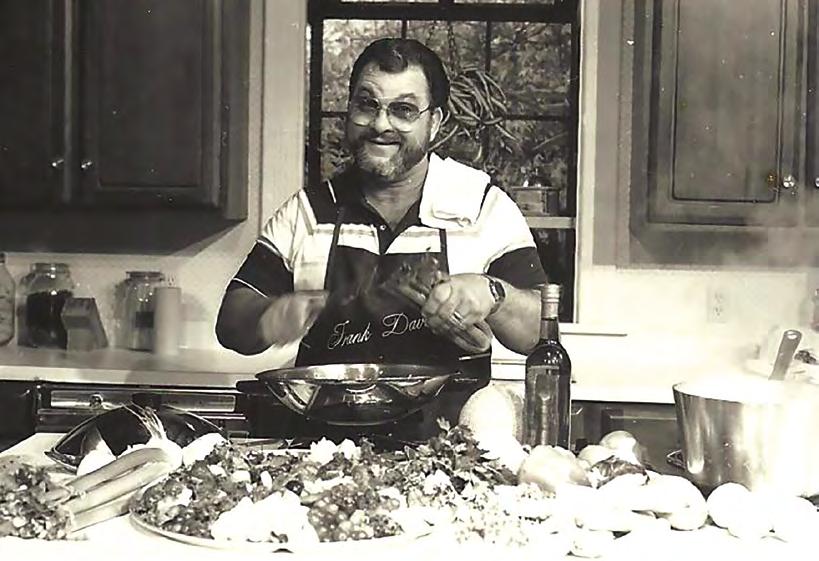
certain times of the year, he would do special themes, like Franksgiving during Thanks giving and Naturally Noel — a take on his ‘Naturally N’Awlins’ catchphrase — during Christmas,” remembers Dominic Massa, Executive Vice President & Chief Operating Officer for WYES-TV and author of the 2008 book, New Orleans Television. “During Franksgiving, he would also print up recipe booklets, and people would be excited to get those to have the special recipes for the holiday. He would put together a whole menu for his Franksgiving feast, so it would be the side dishes, a special way to do the turkey, dessert…and whatever else he came up with.”
Massa recalls that the term “Franks giving” — what he calls a “perfect name” for Frank’s spin on the Thanksgiving holiday — was created by the promotions team at WWL, who also dreamed up other nowvenerated messaging concepts, like the “Spirit of Louisiana” to promote the state’s rich musical heritage and “Bless You Boys” for, of course, the New Orleans Saints.
“Frank was such a fixture, and he oozed New Orleans and South Louisiana. Because
he grew up here and knew the food culture and what people would like, I think it really resonated with what people would want on their Thanksgiving table,” Massa says, noting that Davis even had a small role in helping popularize the turduchen. “Even as a broadcaster, he had a tone of voice where you can hear him in the recipes when you read them.”
No matter how many viewers considered Frank their next of kin during Franksgiving and Naturally Noel, Frank’s wife, Mary Clare, recalls that Frank always found a way to put their tight-knit family first. “Frank just loved every minute of it. As busy as he was, we’d go grocery shopping and plan the menu, and he would pick out what to fix. I don’t know how he got all these wonderful ideas about Thanksgiving, but he did. They used to make little booklets and put them in the grocery stores, and everybody was so excited about all the Franksgiving recipes.”
For the Davis family, the holidays also meant having everyone join in the festivi ties, both on-screen and off. “The grandkids always loved to watch the cooking shows with Frank during the holidays. In fact, my granddaughter, Elise, used to join him a lot of times and go on the set and help prepare the holiday dishes,” remembers Mary Clare, who herself served as Frank’s on-screen assistant for many years. “They were all so interested in what their grandfa ther did. It was just a wonderful time during Thanksgiving and Christmas for everyone to gather and see those things that he enjoyed doing so much and that his family enjoyed watching him do.”
“The recipes he made are simple, but he didn’t make it sound simple. He made it sound like it was the most interesting thing — and they would tease him about that,” laughs Massa. “It might be just cranberry sauce, but he would make it into something really exciting and different, and something that you may have taken for granted that he then elevated in a different way. It also made it fun: I think that was another big part of what he did. He made it interesting, and that’s why he was so successful at it for so many years.”
Frank’s passion for and expert knowledge of the South Louisiana outdoors — and fishing in particular — also factored heavily into his recipe development, and positioned him as one of the first front-and-center advocates for accessible, thoughtful wild-caught
The first time I saw Frank he was in a Louisiana Wildlife and Fisheries uniform…[and] during that time, Frank learned about cooking fish and game as only a person devoted to preserving our bayous and wildlife, and to appreciating the abundance of what we have to eat in Louisiana on a year-round basis, can do. I consider Frank a number-one authority on cooking and eating the fresh fish and game of Louisiana.
— Chef Paul Prudhomme in the foreword to Davis’s 1983 book, The Frank Davis Seafood Notebook
cooking instruction on broadcast television — not just in Louisiana, but nationally. Long before farm-to-table or “locally sourced” seafood could be found on every fine dining menu across the city, Frank Davis was showing exactly how freshly caught fish could not only be prepared successfully but taken directly from Gulf to plate.
“He was so full of knowledge about the seafood industry and seafood in Louisiana, but in fact, he covered quite a bit of area,” Mary Clare recalls. “It wasn’t just Louisiana. It was all about different kinds of the fish from different places and how to fix them.”
“The first time I saw Frank he was in a Louisiana Wildlife and Fisheries uniform… [and] during that time, Frank learned about cooking fish and game as only a person devoted to preserving our bayous and wildlife, and to appreciating the abundance of what we have to eat in Louisiana on a yearround basis, can do,” wrote the late, great
Chef Paul Prudhomme in the foreword to Davis’s 1983 book, The Frank Davis
Seafood Notebook . “I consider Frank a number-one authority on cooking and eating the fresh fish and game of Louisiana.”

“The first time Frank came to our Village East Store in Houma was to make an appear ance for a Crisco promotion, but I remember what he liked about that particular store visit was that it’s right there on the way down to Cocodrie — to the CoCo Marina — coming from New Orleans,” recalls Tim Acosta, longtime Advertising & Marketing Director for Rouses. “I just remember him saying that he felt familiar with the store location, because I guess he was going down there to fish, and that he didn’t mind coming down because it put him that much closer to the Gulf of Mexico! Everybody loved Frank Davis, I tell you. He was authentic. He was like everybody’s favorite uncle and always had stories to tell. Not a chef, or nothing like that, but just always down to earth.”
“Frank was pretty self-taught. He didn’t come from a cooking school or a restaurant background. But he made things fun and relatable, and I think that was a secret to Frank’s success,” Massa says. “As we know, Thanksgiving can also be a stressful time, but he didn’t make putting together the perfect menu stressful. He made it fun. He made it interesting and creative. Also, the recipes were just so Louisiana, with the ingredients he used, the presentation and the style of the dishes.”
There’s a gregariousness and wink-anda-nod affection to Davis’s recipe instruction that make you feel as if you’re joining in on a thrilling kitchen adventure with Frank, the fearless leader, there to guide you every step of the way. With a penchant for
parentheticals that feel like exuberant, justremembered tips (About the salt — check your oysters to see if they are naturally salty before adding the prescribed amount. You may have to reduce the salt if nature has provided!) and no shortage of exclama tion points in his recipes, Frank married together an earnest affection for cooking New Orleans classics with an engaging flair that helped to inspire cooking confidence for more than one generation of fans.
“Let’s face it...the most popular dressing in grand old New Orleans — especially around holiday season — is oyster dressing. And when you spice it up with just the right touch of real Cajun andouille, it’s hard to beat!” Frank writes in a 1995 Franksgiving recipe for his oyster-andouille dressing. “But most folks unfamiliar with it think it’s too hard to make. Not true, cher ! All you do is follow this recipe to the letter, and you got yourself a winner!”
Everything from cauliflower chowder, butternut squash casserole, herb-roasted chicken and rotini pan pie to deep-fried turkey and a crème de menthe and maraschino cherry “yule wreath pie” could grace a Franksgiving menu (surprises always abounded), and the anticipation of each year’s menu drop, constructed in Frank’s signature style, kept viewers waiting with bated breath.
“During the holidays, he would plan all of the menus, and everything would be so new and fresh. He always made a great impres sion, and we had so much fun cooking together,” says Mary Clare. “I was so proud of him. I was a lucky lady.”
Makes 4-6 servings D’ja ever cook your Thanksgiving turkey inside a black pot, Cajun style? Well, you might want to give it a try this year. It couldn’t be easier, and it can only come out pretty and perfect. What’s more, because it’s roasted slowly at a constant temperature, unstuffed, in an old-fashioned Dutch oven, you get one of the juiciest turkeys you ever ate. If you’re a fan of my traditional slow-roasted turkey, you’re gonna love this! Cuz you don’t cook a turkey this way for the turkey — you cook it this way for the gravy!
1 fresh or frozen turkey, 8 to 10 pounds 4 tablespoons poultry seasoning
2 tablespoons kosher or sea salt
2 tablespoons freshly ground black pepper
1 teaspoon cayenne pepper
1 tub butter spread
1 whole, large onion, peeled
4 tablespoons vegetable oil, for greasing the pot
3 heaping tablespoons cornstarch + 1 cup water
First, put the turkey in the sink under cold running water and wash it thoroughly, making sure to remove every single trace of debris from the internal cavity. Then, with paper towels, pat the bird totally dry inside and out, and place it on a sheet of freezer paper on the countertop.
At this point, you also want to preheat your oven to 325°F.
Next, prepare the turkey, front and back, inside and out, with the poultry seasoning, salt, black pepper and red pepper. And I don’t mean just sprinkle it on — rub those seasonings into the bird hard !
Then, take the butter spread and massage the bird liberally — again, both inside and out, until it coats the entire turkey. And be sure you put some of the spread up under the skin too!
Now place the turkey, breast-side up, into a slightly oiled cast-iron Dutch oven large enough to hold the bird plus whatever juices will be rendered out (and you will get juices!). Oh yeah, and you want to cook the turkey unstuffed, except for the whole onion, which you place inside the cavity.
When your thermostat indicates that the oven is right at 325°F, put the lid on the black pot and slide it into the oven on the low-center rack. Then set your timer for about 2 hours and don’t even peek in the pot until the timer goes off. Depending upon the weight of the bird, you can expect it to cook to perfection in about three to four hours (which figures out to about 22 minutes to the pound). Of course, to be sure that you’re correct, I suggest you use a meat thermometer and roast the turkey until the internal temperature in the turkey breast or thigh reaches 180°F.
After the initial two-hour roasting time, you might want to baste the turkey occasionally to keep it moist and help the breast skin to brown beautifully.
Finally, when you’re ready to eat, remove the bird from the pot (it’s going to be so fallapart tender you may have to extricate it in pieces), place it on a serving platter, and finish carving it at the table for your family and dinner guests.
But whatever you do, make sure you whisk together the cornstarch and water into a smooth mixture, stir it into the natural pot drippings, and cook it briefly at a slow boil to create the best-tasting turkey gravy that ever passed over your lips!
And yes, the gravy is really the only reason you do a turkey this way!

Makes 6-8 servings
WHAT YOU WILL NEED:
6 medium mirlitons, boiled, peeled and diced
4 tablespoons butter, softened
1 medium yellow onion, finely chopped
4 whole green onions, thinly sliced
½ green bell pepper, finely diced
½ red bell pepper, finely diced
2 ribs celery, finely diced
6 cloves garlic, minced
1 medium tomato, seeded and diced
1 cup mushrooms, roughly chopped
2 pounds shrimp, peeled and chopped
1 pound Polish sausage, small diced
¼ cup parsley, minced
½ teaspoon rosemary
1 teaspoon salt
½ teaspoon red pepper flakes
½ teaspoon black pepper
4 cups crumbs
1½ cups chicken broth (if needed)
1 egg, well beaten ½ cup buttered cornflakes, crumbled ½ cup shredded Parmesan cheese
HOW TO PREP:
First, take your mirlitons and boil them whole in lightly salted water until an ice pick will pierce them all the way through without using excessive pressure. Then remove them from the pot and set them aside to cool (you can discard the water).
In the meantime, in a 5-quart Dutch oven, melt the butter over medium heat and sauté the yellow and green onions, green and red bell peppers, celery, garlic, tomato and mushrooms until everything is soft and tender (which should take about 5 minutes).
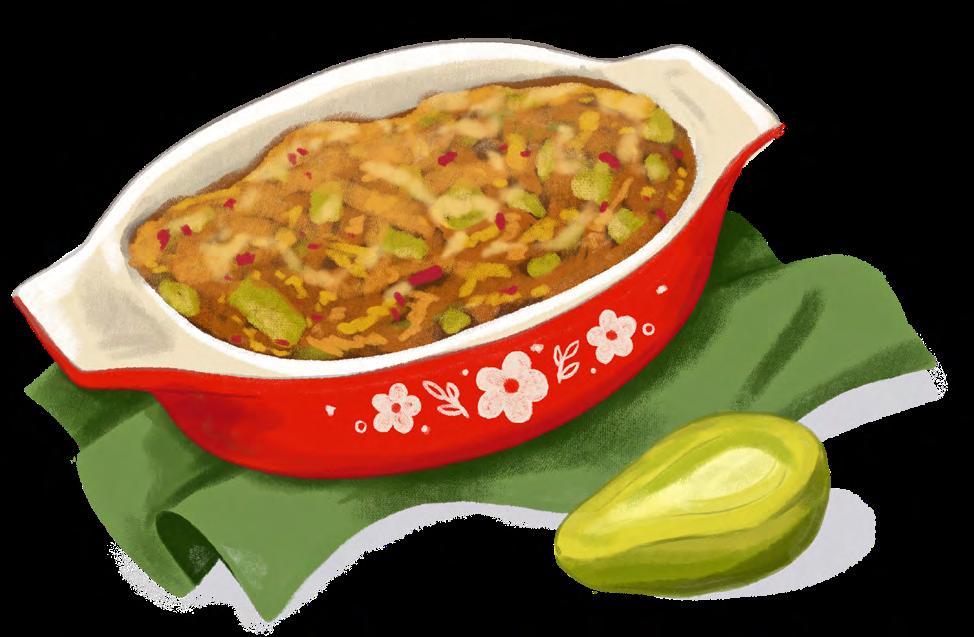
While the seasonings are simmering, slice the cooked mirlitons in half lengthwise, and remove the center seedpods and throw them away. Then take a paring knife and carefully peel the outer skin away from the pulp. Once the skin is removed, dice the pulp into small pieces and set it aside as well.
At this point, preheat the oven to 325°F. Then, turn the fire up under the Dutch oven to high, and drop in the shrimp and the chopped
want them — just pink, not cooked — and the sausage will brown slightly around the edges. When this happens, add the mirliton pulp to the mixture. Then stir the pot constantly for 10-15 minutes, cooking the pulp and the vegetable seasonings together over medium-high heat until a chunky paste forms (it may turn slightly watery, but don’t worry about it). When the texture is just the way you want it, drop in the spices and herbs: the parsley, thyme, rosemary, salt, red pepper flakes and black pepper. Be sure to fold them well into the mirliton, shrimp and sausage blend.
Now it’s time to begin working the French bread crumbs into the casserole mixture (and this is best done a little at a time). When all the bread is added, you should end up with a rather dry paste that tends to stick to the spoon. If it is still too moist, add a few extra bread crumbs, because if the mixture is too wet it will run during the baking process.
If, on the other hand, your stuffing mix turns out too dry, simply moisten it to your liking with a little chicken broth. Then when you’re satisfied with the final consistency, quickly stir in the egg to bind everything together.
Finally, transfer the mixture to a large casserole dish (I find that buttered Pyrex works best). Then liberally top the casserole with the buttered cornflake crumbs, slide the dish into the preheated oven on the center rack, and bake it, uncovered, for about 25 to
30 minutes, or until the topping turns a toasty brown. All that’s left is to spoon out the hot casserole on warm dinner plates, garnish with a little shredded Parmesan cheese, and serve it piping hot right from the oven.
◊ For a little extra enhancement, liberally sprinkle the casserole with shredded Parmesan cheese when it has just 10 minutes left to bake in the oven. This will form a nice crusty topping on the dish.
◊ Remember that mirlitons go well with creamed peas, buttered carrots and a crisp lettuce salad topped with French dressing
◊ When adding the raw egg, stir it into the mixture quickly ; if the casserole hasn’t cooled enough when it goes in, it could actually scramble the egg instead of incorporate it as a binder.
◊ I suggest you don’t add the chicken broth to the mixture until after the shrimp and sausage have had a chance to cook for a while. There will be a certain amount of liquid released from the shrimp, the mirlitons and the mushrooms as they simmer. All in all, you don’t want the final concoction to be too watery or you’ll have to add too much bread to the casserole.
Kevin Belton is a gumbo of English, French, Native American and African ancestry. His mother’s family has roots in the French-Caribbean island of Martinique, and his French-speaking father’s family came from the Bayou Lafourche area of Southeast Louisiana near Thibodaux. Standing six feet, nine inches tall, the big guy has a heart to match his imposing size.
A s a child, Kevin Belton was surrounded by love and food. That love was evident in every bite served by his mother, Sarah Thomas Belton, and her mom, Magnolia T. Battle, when the family gathered around the table. “We tried to have breakfast together every day, but family dinners were a must,” Kevin recalled. Nan, as he called his grandmother, always lived with the Beltons Uptown on Valence Street, just off Freret. That bustling corridor was the place Nan and Kevin regularly shopped. “Across from Canal Villere [longtime New Orleans grocery chain] there was a butcher shop with live chickens and turtles,” Kevin said. “Nan would call to the butcher as we passed, ‘I need two.’ He would quickly dispatch a pair of chickens that we’d pick up on our way home for that night’s dinner.”
Typical of many homes, Kevin’s days of the week were marked by what was for dinner. Mondays meant red beans, Wednesday dinner was panéed meat, and seafood was served most Friday and Saturday nights. There was always dessert. “Mom baked a wonderful homemade chocolate cake. It was yellow cake with her special chocolate icing,” Kevin smiled. “That was always my birthday cake growing up.”
In 1977, while Kevin was in Baton Rouge playing football for LSU, his mom passed away, changing the course of her son’s life forever. “I quit football and came back to New Orleans. I had been studying marketing at LSU, so I enrolled in classes here, but never graduated. Mom always said, ‘Jump on a barge and take it down the river. If you don’t like it, jump on the next one. If you don’t
like that, take one going the other way. That’s been my approach to life.’”
A part-time job with a tourism company led in many ways to Kevin’s role today as New Orleans’ culinary ambassador. During that time, he crossed paths with the New Orleans School of Cooking founder, Joe Cahn, who saw a spark in the young man. “Let’s work together” he suggested, and Kevin was soon the manager of Cahn’s Louisiana General Store. “I learned so much about Louisiana and its food by traveling to buy authentic ingredients for the store. We’d go to Gueydan for Ellis Stansel’s popcorn rice and to Ville Platte for Mr. Ortego’s special hot sauce.” Until it was on the shelf at the general store, the fiery concoction was previously available only out of Mr. Ortego’s trunk!
Within six months at the New Orleans School of Cooking, Kevin found himself following in his mom’s footsteps when he began teaching there. “I guess it was in my blood,” Kevin said. “Mom was a school teacher, and I got to sit in the back of her classroom during the summer watching her

teach. She made class so much fun, so that became my approach.”
Another door opened when Kevin followed his mentor, Joe Cahn, to WYES for the live Showboat Auction. “That was how I learned to do live TV,” Kevin reflected. “Somebody didn’t show up that next weekend and they asked if I could auction a board for them. Before long, I was featured in their pledge breaks, too.” As an only child, Kevin played alone in his room pretending to be people he’d seen on TV. That make-believe helped hone the innate talent for entertaining so characteristic of Kevin Belton today.
When WWL-TV icon Frank Davis died in 2013, the station dedicated the studio kitchen — a place that had been Frank’s domain since the 1980s — to him. An entire month was devoted to Frank’s memory, with Kevin re-creating Frank’s recipes on air every Tuesday morning leading up to the dedication. When the month was over, Kevin was asked to fill Frank’s shoes. Humbled by the opportunity, Kevin thought, “I can’t be Frank. I can only be me. But I do talk to Frank all the time when I’m at the station,” he laughed. “Going through the equipment locker that originally was Frank’s, I’ll say to him ‘Hey! Did you see that?’ wondering what he’d think about some new food craze — like the Cronut.”
Kevin’s years of commercial TV cooking success are unparalleled in the Crescent City. Public television opened its doors in 2015 after Chef Paul Prudhomme retired from his long-running PBS series. WYES Programming Director Beth Utterback asked Kevin to come see her. Utterback said, “Chef Paul retired, and we want you to do the next
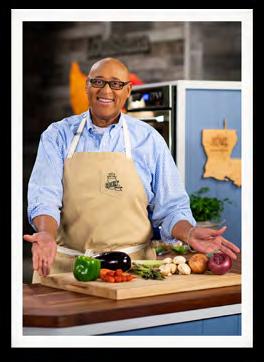
series.” Almost speechless, Kevin remembered: “As I left Beth’s house, I called Chef up on the phone. I felt like I was asking permission. I said to him, ‘I was told you’re stepping back, and they’ve approached me about it.’” The legendary Chef Prudhomme immediately replied, “Take it! Do it and make it your own!” Today Kevin has completed four 26-episode series accompanied by companion cookbooks. PBS affiliates across the country broadcast his popular show.
Kevin credits all he knows today from the priceless knowledge shared so freely with him by New Orleans’ cooking greats. “I have childhood memories of eating at Dooky’s and was eventually blessed to be with Miss Leah in her kitchen. To stand at the stove and be friends with Paul Prudhomme; to hang out with Louis Evans in the Pontchar train Hotel kitchen and with Mike Roussell at Brennan’s,” he marveled. “They taught me and showed me the food but, more importantly, they showed me how to treat people, how to handle the business end of it, as well,” he reflected.
Kevin’s thoughts always return to the women in his life. As important as Kevin’s mom and Nan were in making him the man he is, he credits his beloved wife, Monica, for making him look good today. “Anything you see me do, know it came from her first!” he said emphatically. The inseparable pair make quite a team, as evidenced in Kevin’s latest book, Cookin’ Louisiana, co-authored with Monica.
While Tuesdays remain Kevin’s cooking day at WWL, over time he has become a special field reporter for the station. “When some of the other guys show up, everybody looks around, like, ‘Uh-oh! Who’s getting indicted?’ But when I show up they say, ‘Chef Kev’s here! We’re going to have some fun.’” Just as Frank Davis had his Naturally N’awlins beat, Kevin is busy developing new segments for WWL News called So New Orleans . “It’s about what makes us, us. Think about how we give directions — everything’s lakeside, riverside, uptown, downtown. The crazy way we pronounce things in different neighborhoods…our food,” Kevin laughed.
One thing is certain. No matter what Kevin Belton has a hand in, he is always in it with all of his heart.

ARROW-CIRCLE-RIGHT Kevin Belton’s fourth cookbook and television series focus on the amazing food found throughout Louisiana. The star of New Orleans Cooking with Kevin Belton heads to multiple parishes found across Louisiana to explore dishes and unique flavor profiles associated with each area of the state.

KEVIN BELTON’S COOKIN’ LOUISIANA: FLAVORS FROM THE PARISHES OF THE PELICAN STATE , 2021
Suppose you want to watch a movie about a high-powered businesswoman / a plucky interior designer / a seamstress with big dreams and an Etsy account / an up-and-coming barista / an actress on the cusp of stardom who finds out her dad is sick / learns the family farm is in trouble / is asked to be in her sister’s wedding / is contacted by an attorney about some inherited land two weeks before Christmas / Thanksgiving / “the holiday.” She is reticent to return to her hometown in the picturesque mountains / windswept prairielands / hilly farm country so close to the holidays, but she does, and when she gets there she meets Ryan, the town handyman who knows everyone / Jake, the farmhand with an old but reliable pickup truck / Todd, a young attorney with a new legal practice who just loves this ol’ town / Will, also traveling from out of town who is handsome and rakish, a little sweet and definitely manly.
Our heroine (has had a bad experience with love / doesn’t care much for “the holidays” / has an important meeting back in New York and doesn’t have time for this), and just wants to take care of things and get back to the city. Suddenly, (a snowstorm / an illness that takes a turn for the worst / complicated legal paperwork / a canceled flight) keeps her delayed, and (no cell reception / no internet / a guilt trip from her sassy aunt / a forgotten Macbook charger and of course there are no Apple Stores in this one-horse town) stops her from working. She keeps encountering her handsome admirer, and (the town postman who looks a little like Santa / her cheeky old aunt / her precocious niece / Old Frank who owns the hardware store) thinks the two look great together. Will she (fall in love / stick around for the holiday and have dinner with her handsome new beau’s big family she hardly knows / move back to her hometown now that she knows the true meaning of love and the holidays / all of the above)? You’ll just have to watch and find out!
If you want to watch that movie, then have I got a channel for you. Everyone loves a good Hallmark movie, where there is no COVID, no inflation, no social media anxiety, and no politics (aside from old Mr. Jenkins, the town mayor
with a heart of gold). Who is watching those movies? You are, even if you don’t want to admit it — and you aren’t alone. Eighty million people watch Hallmark holiday movies every year. (There are only 300 million people in the United States.) They’re so popular that Candace Cameron Bure, who is like the Orson Welles of Hallmark movies, quit Hallmark to start her own holiday movie channel.
The important thing to acknowledge about Hallmark movies is that they are pleasures not because they are bad, but because they are so good. All else proceeds from there. They are well-cast and well-acted. The stakes for the characters are low, which is comforting to all of us. The outcome is always positive. More comfort yet. We are, all of us, in some way panicked and lonely and uncertain, subject to relentlessly depressingly news in a world spiraling out of control, and any kind of comfort we can get is a valid comfort.
Strangely, I have never spoken to somebody about Hallmark movies who didn’t describe them as a “guilty pleasure,” but what a mistake that is! Given the choice between, well, everything going on every where, it seems, and a movie where a plucky travel agent falls in love with the goodnatured ranch hand, well I know which one I’d choose.
Once Hallmark figured out the formula, everyone decided to get in on the action.
Lifetime, which was once known for more intense fare, featuring couples and even entire families no one would describe as wholesome (they had way more revenge killings than Hallmark movies, anyway), is now Hallmark Lite. Amazon joined the fray, too (you can always tell which movie is a lighthearted, romantic holiday flick because the people look happy). Netflix? The final few subscribers to it report to me that Hallmarktype movies are standard fare when the holiday season sets in. So ubiquitous is the Hallmark movie that it has transcended its channel of origin and the company that produces them. (I’m just going to call them all “Hallmark movies” here — you know exactly what I am talking about.)
Hallmark movies deliver Christmas. You don’t even have to be Christian to buy into the ideal. White snow piled shoulder high, blanketing every inch of real estate. Carols and cookies and guileless love and good intentions. The shows sustain something inside us all that is woefully malnourished. And they aren’t the first bit of media to do so.
The modern Christmas that we celebrate is in large measure an invention of Charles Dickens. A Christmas Carol is more than a great story about Muppets — so influential was the book that it popularized everything from the phrase “Merry Christmas” to the big family meal we have to celebrate the holiday. It is almost impossible to overstate how

directly instrumental that book was on culture 179 years ago, and your family Christmas gathering today. That’s a pretty good run for any book’s sway. The Christmas invented by Dickens feels right, somehow. A warm, comforting way to celebrate something in a cold, unforgiving world, and a vital message that says, “You can change and this can be your life.” Yes, when you read the book or watch the zillion different movies of it, you are Scrooge.
On some level, Hallmark movies are the apotheosis of the Dickens holiday ideal, but on a deeper level, they are shaping our own perceptions of the holiday season, and what it should be. (Hallmark as a brand has been no slouch, either. You may not believe this, but Hallmark invented modern wrapping paper!) The movies provide an escape from literally every institutional, economic, and political problem in the world. It always snows on cue, the people in your everyday life are pulling for you, working for your happy ending. Houses still have white picket fences! We want to live in that world, and it feels so possible, it’s right there, just out of reach.
The main character has a problem — but not too awful a problem. Home is more than a house, but rather, is a community. (I mean how many people know the name of their mail carrier in real life?) She has an interesting job. Her hometown never looks the way we’ve allowed our towns to look — endless stretches of stoplights, gas stations, fast food, and national chain stores. She’ll never get to her car and find the driverside window has been smashed in and the glovebox rifled through, and wonder how she is going to pay the rent and repair the window. If she is single, she’ll find an effort less love (though not too effortless — there must be tension). (But not too much tension!)
The world we have created looks a lot more like the old Lifetime movies than the new. If for no other reason, it is good to have a touchstone. Something to work toward.
Hallmark has been in the television business since the 1950s. In 2001, the company bought a religious channel, Odyssey, and over the next decade, its schedule started looking a lot less like generic lifestyle and family programming and a lot more like a Thomas Kincade painting. By the mid-2010s, Hallmark went
all-in on Christmas programming. It was, to put it mildly, a success. Eighty million viewers is a mind-blowing number.
Hallmark also has the “Movies and Mysteries” channel, whose fare is best described as wall-to-wall cozy mysteries, where somebody always gets murdered, but nobody ever gets hurt. The heroines sip tea, knit, and get the dastardly coward who killed the beloved neighbor or stole the valuable family heirloom. It’s Scooby-Doo for serious folks — but not too serious!
And if we love Hallmark movies, Hallmark movies love us right back. Quite a few of them are filmed in Louisiana, Mississippi, and Alabama. These are lots of local jobs, lots of big business. The movies are made in about two weeks, and Hallmark alone pumps out a few dozen a year. It takes a lot of solid technical talent to make movies at that pace with that level of quality. These are absolute pros on set.
And their stars have probably been behind you in the Rouses checkout line, and you didn’t even notice. They film here for good reason — we’ve got it all! If Louisiana is good enough for Chris Pratt or Anna Kendrick, it’s good enough for that sort of famous actress who was in that TV show a few years ago I think. A day’s drive down I-10 (with a detour on 55) and you’ll basically be in half the holidays movies you’ve seen where Becky from the big city has to make peace with her estranged brother just in time to light the tree in the town square. To name only a few:
Earlier this year, shooting started on Family Christmas , which is the perfect distillation of every Hallmark movie title. It is being filmed in Sorrento, in Ascension Parish, and is easily the biggest thing to happen in Sorrento since John “Hot Rod” Williams (a Sorrento native) played for the Cleveland Cavaliers in the NBA in the 1980s and 90s.
In 2019, the Lifetime Original Movie A Christmas Wish was filmed in Ponchatoula, and saw Faith, the main character, make a Christmas wish to experience true love for the first time. When she meets Andrew the next day, it seems Christmas has delivered. But is her true love Andrew? Or is it her best friend Wyatt, who was there all along?



Meanwhile, Lifetime also filmed Christmas in Louisiana in New Iberia. In it, a big city lawyer goes back to her hometown to celebrate an annual Christmas festival, and

while there, falls in love with Christmas — and an old flame — all over again.


Hard as it might be to believe, Christmas in Louisiana was not a sequel to 2017’s Christmas in Mississippi, in which Holly, a big city photographer, returns to her hometown of Gulfport to help celebrate an annual Christmas festival, and while there, falls in love with Christmas — and an old flame — all over again.

Lafayette got some love in 2018 with The Christmas Contract, in which Jolie, a big city web designer, goes back to her hometown, where her parents run an annual Christmas Market. While there, she falls in love with her best friend’s brother.
That very same year in that very same Lafayette, on Amazon Prime Video, Hometown Christmas sees Noelle, a big city doctor, returning to her hometown to help resurrect an annual Christmas festival. While there, she falls in love with an old flame.
It would be hard to overstate how huge 2018 was for Lafayette. In Christmas Cupid's
Arrow, a college professor signs up for a dating app and meets a charming attorney named Josh. (Quite an outlandish plot for this kind of movie, but it’s a Prime Video produc tion, which is like the Rose-Art crayons of Hallmark movies.)
I think Hallmark movies have more than one bit of magic working for them. The real holiday miracle is that these movies are filmed in Louisiana during the summer, and nobody looks like they are in 80% humidity. If that’s not a holiday miracle, I don’t know what is.

It might seem like I am making fun of these movies and the cookie-cutter plots, but I am not. I celebrate them with the absurd exuberance that our hero’s hometown celebrates Christmas. These plots are a comforting escape from the everyday battles of modernity. Somehow, there is always that pillowy snow. The towns tend to be generic (though not you, Lafayette, nor you Poncha toula!) but exemplars of the world we want. One problem the network ran into a few years ago is that there are only so many cute
little towns out there. Thankfully, the Rouses readership lives in so many of them.














And if there isn’t enough time for all the holiday magic, Hallmark has found a way to deliver the same idealized world in slightly different forms. The channel has branched way beyond December (though that’s when it matters most, I believe). There’s Valentine’s Day, Spring into Love, June Weddings , and Fall Harvest, among others. Maybe — just maybe — the world we want is doable year-round.
Ultimately, after all, the Hallmark holiday movie is a genre all its own (even if it is not on Hallmark, or isn’t restricted to Christmas). Each appeals to us with a pretty straight forward message: What if things weren’t so bad? What if we were a little nicer to each other? Worthier questions are hard to find. Delivered with a high level of artistry and oftentimes filmed locally — watch those movies with joy in your heart, and tell your friends. A guilty pleasure that is not.






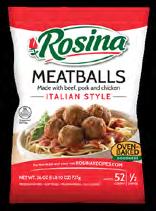


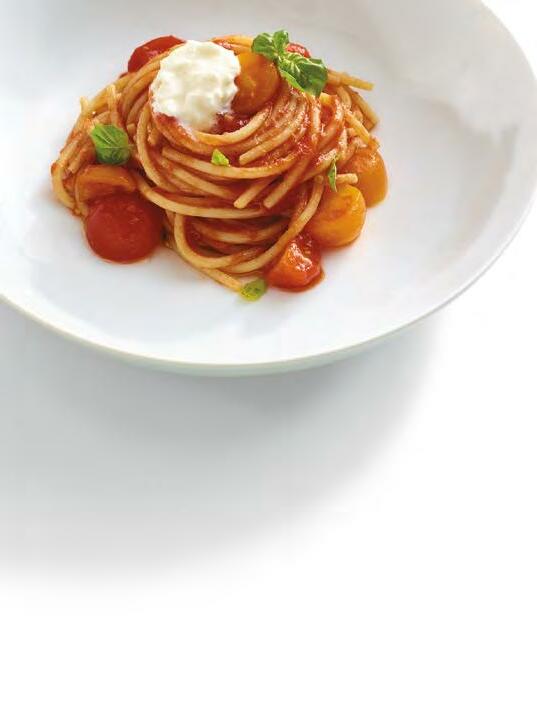




 PHOTO BY ROMNEY CARUSO
PHOTO BY ROMNEY CARUSO
 By Sarah Baird
By Sarah Baird
Growing up as an only child, my status as sole offspring led me into a preoccupation with stories about what it’s like to be raised in a huge, too-many-siblings-to-count families: The Sound of Music with the seven Von Trapp children singing and dancing their way through the days; The Five Little Peppers and How They Grew, which chronicles the ways in which four sister and an elder brother work to care for one another and their widowed mother; and around Christmas time, I would always light up at the thought of rereading my favorite picture book celebrating the raucous, mischievous, morelove-to-go-around nature of cousins in Too Many Tamales by Gary Soto.
Too Many Tamales is about cousins, yes, but it’s also about — you guessed it — tamales: specifically, the MexicanAmerican tradition of gathering extended family around the table each Christmas Eve to assemble an enormous batch of tamales for dozens of aunts, uncles and everyone in-between to enjoy. While each family has their own steeped-in-tradition means of crafting tamales (particularly the filling, which can range from spiced ground beef to a melange of vegetables), Soto’s narration takes a classic, step-by-step approach to explaining classic tamale preparations: splaying out the corn husks, spreading them with masa (corn dough), adding filling, and then steaming them over the stove in batches. The twist? Our young tamale-making hero, Maria, decides to play with her mother’s diamond ring while kneading the masa, and when she can’t find the piece of jewelry after the tamales drop to cook, worries that she’s left it inside a tamale, resulting in the
inspired (if a little rascally) choice to force her cousins to eat through all 24 tamales in an attempt to find the ring. (Spoiler alert: The ring was fine, and the family gladly worked together to make 24 more tamales — a true win-win.)
The book captures not only a sense of gathering and commitment to tradition through cooking, but the ways in which the process of creation and ceremony build a bridge between past, present, and future. Another tradition that remains central to linking future generations to the rituals of home for Mexican Americans is the Feast Day of Our Lady of Guadalupe, celebrated each Dec. 12. The Patron Saint of the Americas, Our Lady of Guadalupe (sometimes simply called “Our Lady”) refers to the Virgin Mary, mother of Jesus, with her annual feast day marking the moment when she revealed herself through an apparition in present-day Mexico that led to Christi anity becoming widely embraced across the country.

“December 12, 1531, was when the appari tion of Our Lady of Guadalupe happened for [recently converted Catholic] Juan Diego during a time when the Franciscan mission aries in Mexico were having a lot of trouble evangelizing to the Indigenous people. The Indigenous cultures there were in the middle of a depression, because their hopes were failing, and in their minds, they were thinking that it was almost the end of the world: something big is going to happen about this time. But even during this depression, when [Our Lady] expressed herself in the appari tion, they recognized her because all the
symbols that are in her image represent that she brings the truly living God to them,” explains Angélica Malmberg, Administra tive Assistant for the Hispanic Ministry at the Diocese of Lafayette.

The image of Our Lady of Guadalupe had appeared several times before to Juan Diego (who was Indigenous) in previous visions, but on Dec. 12, the apparition of Our Lady he witnessed was so filled with rich, identifiable symbolism it moved the hearts of a population toward conversion. Malmberg notes that conversions to Christianity were so widespread across what is now Mexico in the wake of Our Lady’s apparition that it’s said 300,000 people were once baptized in a single day.
“All the elements of the apparition were symbolic to the [Indigenous people] in the sense that they could understand what she meant with her clothes and the gestures. There’s a kind of radiance behind her, like the sun, which for the Indigenous community was God, yet this image was saying to them, ‘This woman is not God, but God is behind her.’ Her hands appear to be in what we call prayer, but for the Indigenous, that position of the hands means offering. And what was she offering? Well, she was offering her son. And how do they know that? Because she was wearing a sash on her waist which was an indication for the Indigenous that this a pregnant woman,” says Deacon Juan Pagán, Coordinator for Hispanic Ministry in the Diocese of Lafayette. “She appears to be a mixture of both Spaniard and Indigenous — kind of like what we say here, Creole, a mixture of races — so it’s another way of
saying that she belongs to everyone. These little symbolisms appearing in the image spoke to them about Mary and the message of salvation through Jesus Christ…and that's when a humongous number of conversions began. The Mexican people, their love for her, it's just outstanding.”
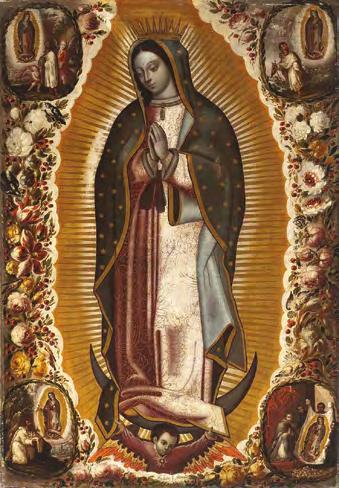
While not all feast day festivities for Our Lady of Guadalupe are the same — some people honor her for 46 days, others begin their ceremonies on the day of Juan Diego’s first apparition, Dec. 9 — the sacred celebration is becoming a more widespread, and well-known, part of the holiday tapestry across the United States as Hispanic popula tions continue to grow. The National Study of Catholic Parishes with Hispanic Ministry released by Boston College in 2014 found that Hispanic Catholics make up roughly 40 percent of the approximately 78 million Catholics in the United States today, and that 25 percent of all Catholic parishes now provide Hispanic ministries, including mass in Spanish. What’s more, the vast majority of these Hispanic ministries inside Catholic churches, 38 percent, are located in the Southeast. Pagán notes that approximately 90 percent of the ever-growing number of Hispanic congregants he serves in Lafayette are from Mexico, so while they might come with small differences in tradition based on where in the country that they’re from, all have a deep love for Our Lady of Guadalupe and her feast day.
“Here in Lafayette, the kind of celebra tions that we do reflect the traditions that are in Mexico. We have a diocesan-wide celebration on December 12, on the official Feast Day of Our Lady of Guadalupe, and historically, it was just that celebration. But as the Hispanic community has grown in size across our area, now we’re beginning to see the different parishes doing their own celebrations in addition to the one that we do in the diocese.”
The ceremony honoring Our Lady is a thing of profound, grassroots-led beauty, and from the delicate, multi-colored paper garlands that adorn the cathedral’s exterior, known as papel picado, to the traditional dancers, known as danza Guadalupana, a sense of community and cooperation shines during the feast day.
“What the celebration entails is a proces sion around the cathedral, which includes
several groups of Indigenous dancers who honor Our Lady through their dance, and then the choir, the people, go singing through the entrance of the cathedral and bring the image, the statue of Our Lady, with them. The children are encouraged to dress up as little Juan Diegos and the girls to dress like little Our Lady of Guadalupes. It’s the cutest thing. They bring flowers to Our Lady, symbolic of the miracle that happened when the bishop was requesting proof from Juan Diego that these apparitions were real, and Our Lady did the miracle of making flowers bloom in the middle of winter. We try to have a choir that is combined with the different people from different parishes to have a sense of unity. Then after the bilingual Mass, we have a celebration that’s just a big old Mexican feast: good food, dancing and music.”
And the one food Pagán and Malmberg raced to answer is the most popular dish during the Feast Day? Homemade tamales, of course.
“One thing that had always impressed me as we go through the process of preparation for the feast is the amazing and beautiful love and devotion that everyone has for Our Lady. They get so excited to decorate the outside the cathedral. Last year, it was raining, it was cold, but it’s a great honor make the decorations for the Feast Day, so they were so happy to do it no matter what. I mean, sometimes it brings me to tears to see the efforts and the generosity of bringing things to the table. Whether it’s money that is needed, or food, or decorations — I mean,
you name it — if it's for Our Lady, they’ve got it,” says Pagán, who also notes that posole (which he describes as “a Mexican gumbo”), horchata and moles are also popular Feast Day dishes.
Generosity sits at the heart of Our Lady’s Feast Day, and speaks to just how important capturing the revolutionary, heart-changing nature of her apparition is for Hispanic communities each year.
“The dancers are also so interesting because it’s not something that we coordi nate. These are people who love Our Lady so much that they come together in their communities to dance for her. They make their own costumes, and they not only come to our celebration, but they also actually visit different homes and honor Our Lady in the particular home of a family who requests it,” Pagán explains. “You have adults and children dancing, and these are people who work late, so they get together really late to rehearse, and sometimes they will be in a parking lot practicing until 2:00 in the morning. And what always impresses me is the fact that they do this at no cost. They never say, ‘Hey, we’ll go to your celebration and dance for you. It will just cost you this and that.’ No, everything is at no cost. This is something that they do in honor of Our Lady.”
Continuing this overflowing of generosity, Hispanic members of Our Lady of Sacred Heart in the nearby small town of Church Point spent their leftover fundraising money from last year’s festivities on a singularly precious gift for Feast Day: a new statue of Our Lady of Guadalupe specifically made for the ceremony, her radiance all aglow, which Malmberg traveled to pick up in Mexico earlier this year. This holiday season, the deeply held connection to home felt by Mexican immigrants in Lafayette will be even more meaningful when the new statue graces the doors of the cathedral for her first official celebration: a homecoming that will certainly be felt by all from first vigil to final tamale.
“For immigrants, celebrating Our Lady of Guadalupe is a way of going back home because it just brings that reality back to where they are and what matters to them,” Pagán reflects. “It’s a feeling that they're at home.”
ARROW-CIRCLE-RIGHT Old Style New Orleans Tamales are made from the original recipe of Fiesta Hot Tamales, which serviced New Orleans from the late 1940s to 1983. After Fiesta shut down operations, the owners decided to give their secret recipe to Armand Buwe Jr., who had worked for them over the years. Old Style tamales are rolled by hand. They are sold out of nostalgic yellow and red wooden carts on the streets of the West Bank of New Orleans, at the Snack Shop in Slidell, and in microwaveable bags at select Rouses Markets.
ARROW-CIRCLE-RIGHT Mickey Brown’s Hot Tamales have been around since the mid ’50s. These Houma-made tamales are also wrapped in parchment paper, New Orleans-style — but come packaged without a sauce.


ARROW-CIRCLE-RIGHT The recipe for the Original Zwolle Tamale is from an old Spanish and Native American recipe — the Northeast Louisiana town of Zwolle, Louisiana, was originally a Native American village. Zwolle Tamales are made with pork, ground corn and a variety of spices, and wrapped in corn “shucks.”
ARROW-CIRCLE-RIGHT Padrino’s authentic corn-shuck wrapped tamales come in unique, heat-in bags. Whether you re-heat one or a dozen, these original, one-of-a-kind tamale vacuum-sealed boilable bag keeps the tamales fresh and at just the right moisture level. The Irving, Texasbased company is owned by third-generation tamale makers. Available at select Rouses Markets.
 By Sarah Baird
By Sarah Baird
Like many families with Italian roots, the Acosta clan gathers for a Christmas Eve feast filled with joy and pasta. For years, it was Cindy Rouse Acosta’s father, Anthony J. Rouse Sr., who made the meal’s centerpiece — a heaping pot of spaghetti and meatballs.
 PHOTO BY ROMNEY CARUSO
PHOTO BY ROMNEY CARUSO
Mr. Anthony’s father had immigrated to the United States from Sardinia in 1900 and opened a produce business, thereby laying the bedrock on which today’s Rouses Markets was built. (The company still remains familyowned as it stretches across the Gulf Coast.) Mr. Anthony passed away in 2009, and his daughter, Cindy, has since taken up the ladle, making the spaghetti that is as much a part of Christmas Eve for her family as the decorated tree and piles of presents.
But into this festa Italiana has now come a new tradition, a culinary interloper with its own rich ancestral roots, deep family lore and a new generation ready to carry it forward: a classic Cuban flan.
The purveyor of this newcomer is Gloria Acosta, the wife of Chris Acosta, Mr. Anthony’s grandson. Gloria’s mother, Dora Johnson, grew up in Cuba until her family was forced to flee Fidel Castro’s brutal regime in the 1960s. Since then, cherished family recipes have kept them anchored to the island in ways that only food and memory can.

Dora was just 11 on Epiphany, Jan. 6, 1967, when she and her family left Havana behind. They arrived in Miami, where they stayed about a year and a half before making their way to New York.
Dora, a nurse, eventually married and moved to Baton Rouge, where her husband was a professor at LSU. When she settled in Louisiana’s Capitol, Dora brought the flavors of Cuba with her, having learned to cook from both of her parents.
“They made all kinds of Spanish Cuban food,” she said. “My mom was very good at Cuban tamales; she used ground pork, boiled the whole corn, and used the leaves for the tamales. My father is also a very good cook, he helped my mother’s cooking grow with his stomach.” A seafood paella is quickly mentioned when Dora and her daughter Gloria share memories of Abuelo’s cooking.
But few recipes are as treasured — or as rich — as the family’s flan, a dessert with an amazing alchemical balance of milky and sweet. It makes appearances on festive occasions, birthdays and holidays. Dora can

recite the recipe from recall, and, though she’s precise on ingredients, the steps come with built-in muscle memory. “My flan is my mother’s flan,” she said. “I can’t tell you exactly when it’s ready. You just know it when you see it.”
Though she adds her own touch — drizzling the finished flan with cognac after it’s flipped out of the pan — Dora adheres close to tradition with most steps of the recipe. There’s comfort in knowing that, even in this ever-changing world, some things are perfect just the way they are.
While Dora remains the chief flan-maker in the family, Gloria has often joined her in the kitchen. When Dora broke her wrist in 2021, Gloria stepped into the culinary breach. The flan made it to Christmas Eve without fail.
The Italians and the Cubans have at least one thing in common during the holidays: Both groups traditionally celebrate on Christmas Eve. La Vigilia di Natale in Italy and La Noche Buena in Cuba are when extended families gather and the feast is laid.
In Cuba, gifts were not traditionally part of the festivities on La Noche Buena, and presents weren’t brought by Santa Claus. They arrived with the Magi. Gifts were exchanged on El Dia de Los Reyes — the Day of the Three Kings, Jan. 6. (This is the same holiday as Twelfth Night.)
For many Cubans, La Noche Buena is one of the most festive nights of the year, a celebration when the best cooks in each family get to show off their skills. Drinking, dancing and eating stretch through the night until the church bells ring, beckoning everyone to head to Midnight Mass. The next day, Christmas is quieter, a welcome chance to snooze off the exertions of the prior evening.
The star of La Noche Buena is the lechon asado, a whole pig, long marinaded and garlic spiked, wrapped in banana leaves and roasted, often in the backyard. Accom panying the roasted pork are traditional Cuban fare: the black beans and rice poeti cally called moros y cristianos; tostones, those addictive savory fried plantains; and yuca con mojo sauteed in garlic.
PHOTO BY ROMNEY CARUSOCrèma de Vie, a more potent, rum-laced version of eggnog, lubricates the festivi ties, while buñuelos, powder-sugar-dusted Cuban-style beignets, force everyone to save room for dessert.
A New York Times reporter once described La Noche Buena in terms that American appetites could quickly understand, saying it combined the “belt-loosening largess of Thanksgiving with the conviviality of a Fourth of July barbecue.”
Dora and other Cubans who left as children have rich memories of Christmas on the island, keeping the decorations up until Jan. 6 when the presents arrived. But after 1959, when the Communist party took power, everything changed — and Christmas was no exception. A deeply Catholic country for centuries, religion was suddenly outlawed, and in 1962, the Cuban government deemed anyone associated with Catholi cism an agent against the revolution.
In 1969, the Communist government made the ground-shaking decision to ban the public celebration of Christmas. “Even private Christmas trees and decorations were regarded with suspicion,” reported The New York Times. “All people were required to work on Christmas Day, ostensibly on the ground that religious trivialities could not be allowed to interfere in sugar production.”
Things began to slowly change again in the 1990s, thanks almost entirely to a five-day visit by Pope John Paul II in January 1998. “Castro attended nearly every papal event and sat in the front row at Masses,” Reuters reported on the Pope’s monumental trip, which “galvanized the local church, infusing it with more courage to stand up to the communist government on human rights abuses and to press for the release of political prisoners.”
In the years since Pope John Paul II’s visit, Christmas has remained a recognized religious holiday in Cuba. And since 2015, when there was a visit from Pope Francis, Catholicism has rebounded, “gradually expanding its role and influence after suffering repression for decades,” Reuters reported. “It now has more autonomy than any organization outside the auspices of the Communist party.”
For many Cuban families who left more than half a century ago, telling stories of life on the island, sharing memories
from one generation to the next, and, of course, cooking favorite recipes, keeps them grounded in a vibrant culture that has withstood unfathomable hardships — and survived.
And that leads us back to flan, a dessert so beloved that “it’s not rare to find an all-flan (dessert) lineup — de leche, de queso, de calabaza, and, of course, de coco” in Cuban restaurants, writes Ana Sofia Pelaez, author of The Cuban Table, A Celebration of Food, Flavors, and History, published by St. Martin Press and nominated for a James Beard Award in the international cookbook category.
“The trick to a great Flan de Leche begins and ends with the caramelo — the sugar heated slowly over a steady flame until it reaches just the right amber hue without becoming bitter,” writes Pelaez, whose recipes also can be found on the website HungrySofia.com. Her flan recipe calls for cooking the caramel for five to eight minutes, watching it carefully while the sugar melts. “It can get away from you easily, but it’s always fun to see how far you can take it.”
Dora also advises keeping a close watch on the pan as the caramel is cooking, swirling it so it coats the bottom of the pan completely, then following the rest of her recipe’s steps. (Don’t miss her recipe below!)
Once it’s perfectly cooled, it’s time for the flipping of the flan. At the Rouse family Christmas Eve party, Chris Acosta often has the pleasure of doing the honors. “I’d say, I’ve now flipped it about five or six times,” he said. “No mishaps, but I’m always very cautious because I don’t want any mistakes on my part!”
As the flan cools, it can create a seal with the pan. So, after the flan is fully cooled, run a knife around the edges to loosen it from the pan. When ready to flip, gently tap the pan to further loosen it. Then place a plate on top and invert the pan; the custard should slide out while still holding its form.

If done right, it’s worthy of a celebration — the perfect sweet finish for a spaghetti feast.
Makes 6-8 servings
For Flan: 6 tablespoons sugar
3 whole eggs
2 egg whites
1 can (12 ounces) evaporated milk
1 can (14 ounces) condensed milk
Pinch of salt
½ teaspoon vanilla extract
For Caramel Sauce: 6 tablespoons sugar
2 tablespoons water
Preheat oven to 350 F.
Mix 6 tablespoons of sugar, all eggs and egg whites, the evaporated milk, condensed milk, salt and vanilla extract in a blender, or mix well with a handheld mixer. Set aside. Next, make the caramel. Put the remaining 6 tablespoons of sugar and 2 tablespoons of water in an oven-safe pan over medium heat. Stir the sugar as it cooks. It gets very hot, so be careful. Make sure it coats the sides of the pan until it turns a rich amber color. Watch carefully so the mixture does not burn. Once the caramel is done, add the blended mixture to an 8” pan. Put the pan in a water bath. Bake covered with aluminum foil for an hour. Remove from oven and let cool completely. Then slide a knife gently around the edges of the flan to loosen it from the pan. Refrigerate the entire pan with the flan inside. Flip it out of the pan before serving. Drizzle with cognac and serve with Cuban espresso.
The perfect accompaniment for flan is Café Cubano — the sweet, strong brew that is served in every Cuban home.
Ground dark roast espresso, such as Bustelo 2 tablespoons sugar or more to taste
Using a 6-cup stovetop espresso maker, fill the lower chamber with cold water. Insert the funnel and fill with espresso. Pat smooth with the back of a spoon to level off, but do not press down. Replace the upper chamber and screw tightly. Place the pot over low
heat. Pour the sugar into a glass measuring cup. When the coffee begins to percolate, take the first few drops and add it to the sugar. Return the pot to the heat so that it continues to percolate. Beat the coffee and sugar vigorously with a spoon or whisk to form a pale and creamy paste. Add a few more drops of coffee if needed to incorpo rate all of the sugar. Pour in the remaining espresso in a steady stream and mix until well blended. Pour into the individual demitasse cups and serve.
Makes about 5 cups
1 cup water
1½ cups sugar
1 can (14 ounces) sweetened condensed milk
1 can (12 ounces.) evaporated milk
4 large egg yolks
1½ cups white rum
1 teaspoon vanilla extract
Pinch of kosher salt
Ground cinnamon
Ground nutmeg
Combine the water and sugar in a saucepan and bring to a boil. Simmer over medium heat until it thickens slightly and registers 230 F on a candy thermometer, 15 to 20 minutes. Set aside to cool. Combine the condensed milk, evaporated milk, egg yolks, rum, vanilla, salt, cinnamon and nutmeg to taste in a blender and pulse until well blended. Pour in the cooled syrup and blend on high speed until frothy. Keep chilled until ready to serve.
 By Alison Fensterstock
By Alison Fensterstock
Jelly Roll Morton called it the “Spanish tinge” — and when he described jazz to folklorist and field recorder Alan Lomax during the pair’s famous 1938 Library of Congress recording sessions, the piano man made it sound like a recipe.
“In fact, if you can’t manage to put tinges of Spanish in your tunes,” Morton explained to Lomax, “you’ll never be able to get the right seasoning, I call it, for jazz.”
Morton’s seasoning was in the right-hand syncopation that turned blues and ragtime into something else. What he called “Spanish” was more accurately Cuban. These were the tresillo and habanera rhythms, both with African and European ancestry that had become something else in the New World in the 18th and 19th centuries. And now, after traveling north to New Orleans, was influencing what would be one of the greatest developments of the 20th: jazz.
The commonalities between New Orleans and Cuba began evolving long before the habanera put its stamp on jazz music, though. Cuba was under Spanish colonial rule for close to 400 years, and for 40 of those, at the end of the 18th century, so was New Orleans. The architecture of the French Quarter shows Spanish influence in its ornamental wrought-iron gateways and balconies, colorful stucco, tiled roofs, and courtyard oases, since rebuilding after two major fires in the 1780s and ‘90s took place under Spanish rule. It’s no accident, then, that if you squint a little bit in the streets of Havana, it can feel very much as if you’ve been transported about 600 miles northwest across the Gulf of Mexico to Jackson Square. Two of the most impressive buildings in the French Quarter, the Cabildo and the Presbytere (flanking St. Louis Cathedral), were built under Spanish rule and have clear architectural siblings in Havana.
Recipe from The Cuban Table, A Celebration of Food, Flavors, and History, published by St. Martin Press Recipe from The Cuban Table, A Celebration of Food, Flavors, and History, published by St. Martin Press PHOTO: “A TUBA TO CUBA”
 PHOTO BY MICHAEL WEINTROB
PHOTO BY MICHAEL WEINTROB
The culture share between the two functioning sister cities isn’t a thing of the distant past, either; closer to New Orleans than Louisville, Kentucky, in mileage, for example, Havana was an important and consistent commercial partner to New Orleans up until the trade embargo of the early ‘60s. According to a piece looking back on the ties between the two cities by historian Joshua Goodman in the Louisiana Endowment for the Humanities’ quarterly magazine, then called Lousiana Cultural Vistas, just before the Eisenhower administra tion’s embargo came down in 1960, Mayor Chep Morrison sent Fidel Castro several invitations to visit New Orleans. Castro never accepted, and Morrison never got to take him to Galatoire’s (where, one would assume, he would have had to borrow a house sport coat to wear over his everyday military uniform). But when the revolutionary leader begged off, Morrison traveled himself to Castro’s Carnival de Libertad in Havana with three floats from the Rex organization, plus jazz bands from Bourbon Street, marching band majorettes, and more entertainment.

Long renowned for its diligence in retaining jazz traditions in the city where those sounds were incubated, trad jazz and brass band music have been on the nightly menu at Preservation Hall, the historic nineteenthcentury carriageway building on St. Peter Street in the French Quarter since its earliest days. To its many fans, Preservation Hall is roots – but in recent years, this keeper of an old flame has also been exploring its own roots, and that path has led to Cuba. In 2015, the band sojourned to Cuba for a gig at the Santiago Jazz Festival and found themselves swimming in what felt like their own history. The trip gave rise to the heavily Afro-Cuban album “So It Is” in 2017 and set them on a
path across the Gulf they’d travel again and again; the award-winning 2018 documen tary A Tuba To Cuba follows the band on that initial group trip, from the city jazz festival to small villages, where drummers raised on parade rhythms slip easily into step with their Cuban counterparts, and a conga parade in Santiago de Cuba could easily be mistaken for a second line.
More recently, New Orleans bands — including funk-rock’s Tank and the Bangas, Trombone Shorty, and others — along with students from the Trombone Shorty Foundation presented instruments to Cuban schoolchildren, jammed in the classroom, and broke out in a raucous second-line parade together in the streets of old Havana during a five-day cultural exchange visit to Havana.
“It was just a wonderful, unexplainable feeling,” Troy “Trombone Shorty” Andrews told NPR’s Alt.Latino, whose crew covered the events. “A lot of joy and love and conver sations, musically, through the instruments.”
“And I forgot that I was here, because some of the dance moves and the way people were moving their bodies to the rhythm is exactly what I experience in New Orleans, when we do second lines. I saw this guy – he looked exactly like my one of my uncles in
ARROW-CIRCLE-RIGHT The Cuban sandwich – bread, smoked ham, roasted pork butt, cheese, pickles and yellow mustard – is more associated with Miami’s Little Havana than Havana-Havana.















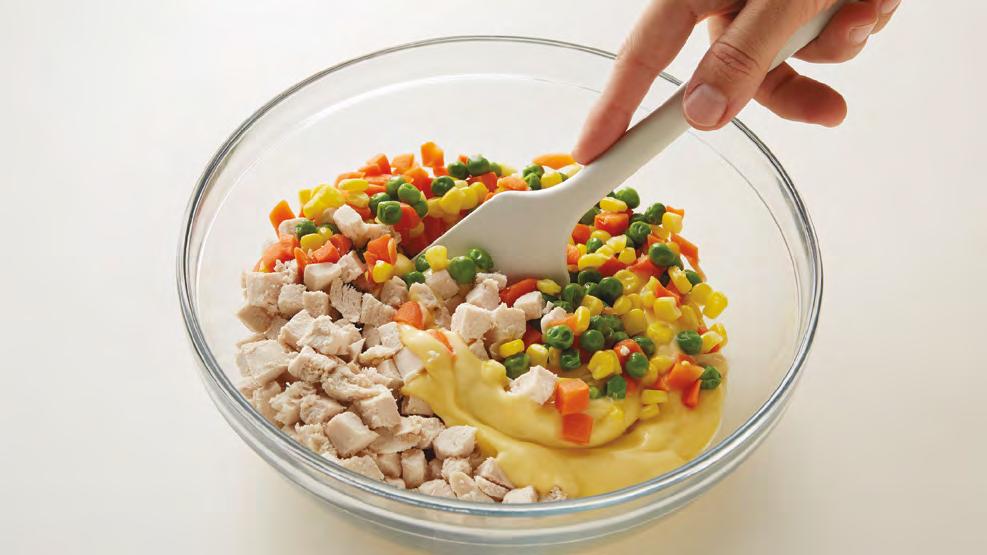


We offer complete holiday meals (turkey or ham) with traditional fixings, as well as dressings and side dishes available à la carte. Our chefs can also prepare large pans of your favorite comfort foods, local favorites or any of our signature items. All you have to do is heat and eat. For locations, phone numbers and a copy of our holiday menu, go to www.rouses.com. This year, please remember to plan ahead and order early.
ROUSES COMPLETE HOLIDAY MEAL INCLUDES: Turkey or Ham with Cornbread Dressing, Turkey Gravy, Sweet Potato Casserole, Cranberry Orange Relish, Green Bean Casserole & King’s Hawaiian Rolls
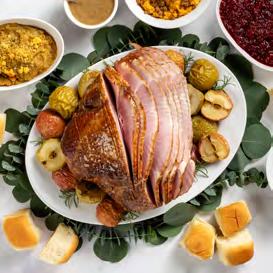

dressing is generally made with
beef or pork, whereas dirty rice is made with pork and chicken livers. But, for most of us, the names are interchangeable.
dirty rice is beef-based and extra dirty.

ARROW-CIRCLE-RIGHT Across the Gulf South, there’s a genre of casserole that’s long been a part of family repertoire, and it includes Shrimp and Mirliton Dressing. We make ours with Gulf Coast shrimp and cornbread.
ARROW-CIRCLE-RIGHT Created by Dorcas Reilly in 1955 for the Campbell Soup Company, green bean casserole has become pretty much synonymous with the time of year when the weather (hopefully) turns a little colder. Reilly created the dish with the hopes it would be something simple that families could whip up with ingredients that they already had stocked in their pantry. The casserole’s thickening agent, Cream of Mushroom Soup, plays the all-too-pivotal role of binding everything together when the dish is bubbling up in the oven.

ARROW-CIRCLE-RIGHT Spinach Madeline is one of the most famous recipes in the River Road Recipes cookbook series. It was invented by St. Francisville, Louisiana, native Madeline Wright in 1956 and published three years later in the first edition of the cookbook.
ARROW-CIRCLE-RIGHT The first recipe for marshmallow-topped sweet potato casserole was published by a marshmallow manufacturer, the Angelus Marshmallow company, in 1917. Our casserole has a cinnamon-oat streusel topping. If you like, add marshmallows and pecans at home.
ARROW-CIRCLE-RIGHT We use whole Gulf Coast oysters with their liquor, the natural juice found inside of raw oysters, for even more flavor.


ARROW-CIRCLE-RIGHT Muffaletta is the name for both the round, seeded Italian bread with origins in Sicily and the New Orleans original sandwich that gave the bread its best and highest use.

Salvatore Lupo, a Sicilian immigrant, opened Central Grocery in 1906 on Decatur Street in the New Orleans French Quarter. Many of the produce peddlers and truck farmers who sold their produce at the nearby French Market were also Italian and Sicilian. When peddlers and farmers, and dockworkers and laborers from close by, came to Central Grocery for lunch, they would order sliced Italian meats, cheese, olives and pickled vegetables, and a loaf of muffaletta bread. Lupo suggested putting this antipasto of sorts directly on the bread, and the muffaletta was born.
Central Grocery’s French Quarter building received significant damage from Hurricane Ida last year, but you can still get their famous muffalettas at our Rouses Market in Downtown New Orleans at 701 Baronne Street — and more locations are coming.
 We served our muffaletta porchetta on Italian seeded bread topped with olive salad and provolone cheese.
We served our muffaletta porchetta on Italian seeded bread topped with olive salad and provolone cheese.
MUFFALETTA PORCHETTA


Makes 8-10 servings
7-pound piece fresh pork belly
3 tablespoons ground fennel or 1 tablespoon whole fennel seeds, ground ½ cup chopped fresh rosemary leaves
½ cup chopped fresh thyme leaves
2 teaspoons chopped fresh sage leaves
12 garlic cloves, peeled ½ cup extra virgin olive oil
Rouses Olive Salad Mix
1 pound sliced mortadella or ham
1 pound sliced provolone cheese
Onion powder
Kosher salt to taste
Freshly ground black pepper
Using a sharp, strong knife, score the fat of the pork belly, taking care not to cut down to the meat. This encourages the fat to render outward and baste the pork, creating a crisp crust. Sprinkle generously with salt. Refrigerate uncovered at least 6 hours and preferably overnight to dry out the skin and make it crispy.
Meanwhile, in a food processor or with a mortar and pestle, combine fennel seeds, rosemary, thyme, sage, garlic, salt and black pepper. Add oil and process until a smooth paste forms, around 20 to 30 seconds. Cover with plastic wrap and set aside.
Remove pork belly from refrigerator and bring to room temperature before making your pork roll. When you are ready to cook, place scored side of pork belly face down on your cutting board. Spread olive salad over entire top of belly. Arrange mortadella and provolone cheese on top. Starting with the side closest to you, roll belly around the msortadella and cheese so the short ends of the belly meet, and secure with kitchen twine. Rub the outside of the pork roll with onion powder , salt and freshly ground black pepper, taking care to work mixture into the crosshatches. Adjust oven rack to middle position and heat oven to 350°F. Transfer the pork roll, fat side up, to a large roasting pan. Cover tightly with aluminum foil. Place in preheated oven and cook until pork registers 180°F as measured by a meat thermometer, around 2 to 2½ hours. Remove pan from oven and increase oven temperature to 500°F. Carefully remove and discard foil, and transfer pork roll to large plate. Discard liquid in pan. Line pan with foil. Remove twine from roast; return roast to pan, directly on foil; and return pan to oven. Cook until exterior of roast is wellbrowned and interior registers 165°F, around 20 to 30 minutes.
Transfer porchetta to a carving board and let rest for 20 minutes. Slice roast in one-inch thick slices, then transfer to serving platter and serve.
ARROW-CIRCLE-RIGHT In Italy, porchetta (pronounced pohr-KEHT-tah) is a pork roulade, or roll. Although porchetta can be found throughout Italy, most notably in the west central region of Lazio, it likely originated in the central region of Umbria. In Costano, near Assisi, there is a museum of porchetta; in San Terenziano, there is a festival called Porchettiamo devoted to porchetta.
Traditionally, to make porchetta, a whole suckling pig is deboned, filled with aromatic herbs and spices, and spit-roasted, with fat and skin still on, over juniper wood fires, or roasted in pits until the outer rind is crunchy.
But a whole pig is not practical for most of us, nor is spit-roasting over juniper wood fires. To make porchetta at home, wrap a pork loin or pork roast with pork belly; the fat from the belly will baste the meat as it cooks, so you get the same layers of meat with pork fat and crackling-crisp pork skin. No belly? You can just use any boneless, well-marbled roast with skin or a thick fat cap and get the same juicy effect.
 PHOTO BY ROMNEY CARUSO
PORCHETTA
PHOTO BY ROMNEY CARUSO
PORCHETTA
Our bacon-wrapped tenderloin has a crackling crust, like an Italian porchetta, but there’s no work required. We also have stuffed versions.
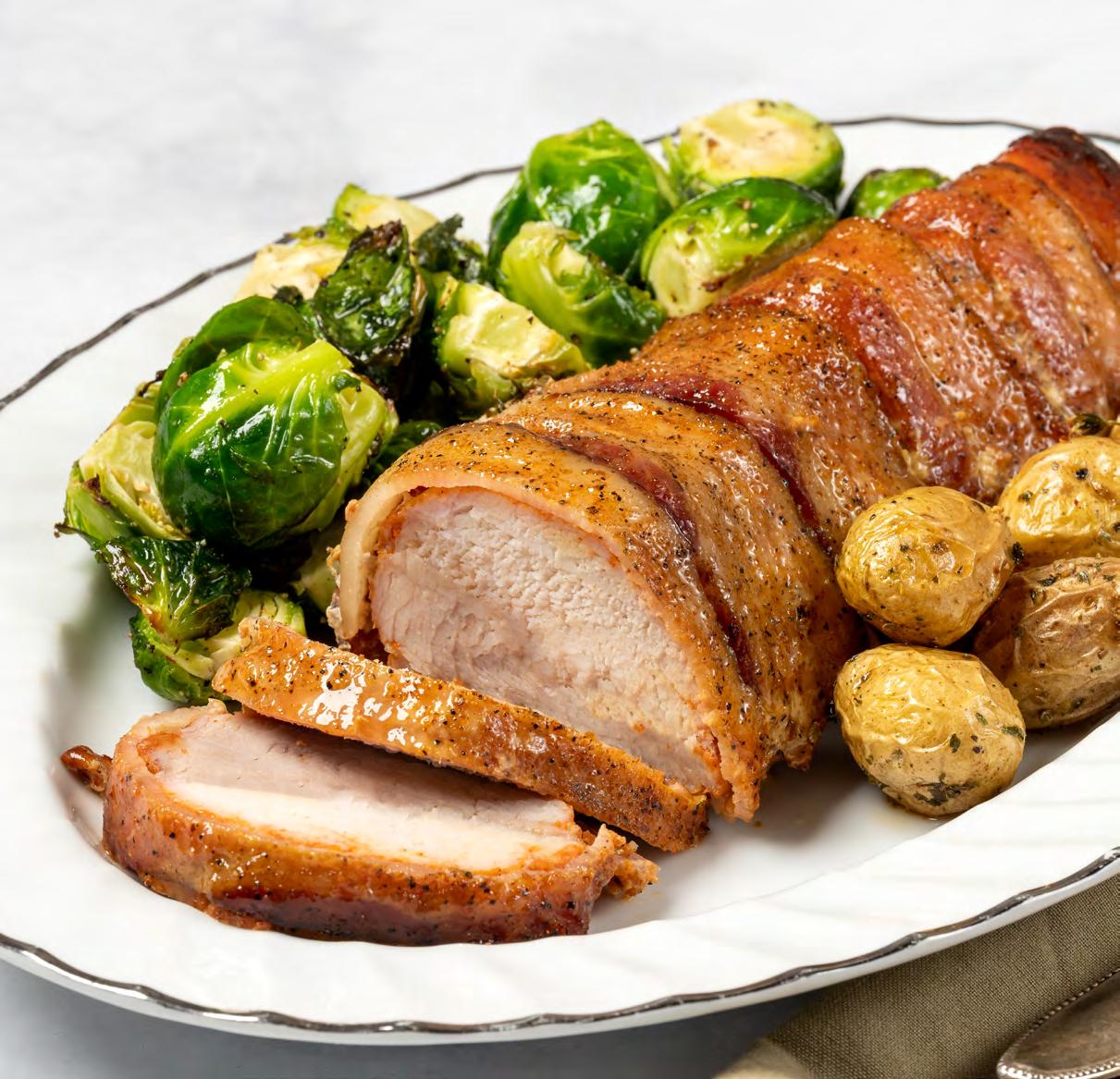
Makes 6-8 servings
2 tablespoons extra virgin olive oil
½ cup pancetta, small-diced (5 ounces)
3 tablespoons minced shallots
1 tablespoon minced garlic
2 pounds fresh brussels sprouts, washed, trimmed and halved
Salt and pepper, to taste
¼ cup balsamic vinegar
2 tablespoons brown sugar
½ cup chicken stock
2 tablespoons chopped parsley
½ cup Italian bread crumbs
Heat olive oil in a large skillet over mediumhigh heat. Add pancetta and sauté until crispy, about 10 minutes. Add shallots and garlic, and sauté until fragrant, around
2 minutes. Add brussels sprouts. Sprinkle
with salt and pepper and sauté, tossing frequently, until lightly browned, about 5 minutes.
Increase heat to high. Add balsamic vinegar, and stir in brown sugar and stock. Cook, tossing frequently, until sprouts are glazed and tender, about 10 minutes. Transfer to a serving bowl, and top with chopped parsley and Italian bread crumbs.
PHOTO BY ROMNEY CARUSOARROW-CIRCLE-RIGHT Porchetta is a type of rolled roast pork that may contain pork belly, while pancetta (pronounced pan-CHET-ta) is just pork belly. Pancetta is sometimes called Italian bacon. But while most American bacon is smoked, pancetta is salt-cured with sweet and savory spices.




ARROW-CIRCLE-RIGHT Turkey is a relatively lean bird, particularly the breast meat, so it doesn’t have a lot of fat to help keep the meat from becoming dry and tough during cooking. This is where brining can help. A brine is a basic solution of water and salt. During brining, the turkey absorbs extra moisture, which in turn helps it stay moister and juicier, both during and after cooking. Since the turkey absorbs salt along with the water, it also gets nicely seasoned from the inside out. The salt also breaks down some of the turkey’s muscle proteins, which helps with the overall moisture absorption and also prevents the meat from toughening up quite so much during cooking. Remember to remove the turkey from the brine one hour before you’re ready to cook it, and pat it dry inside and out. Let it stand for up to 1 hour before cooking.


ARROW-CIRCLE-RIGHT Giblets can add both flavor and texture to turkey gravy. Take the giblet bag out of the turkey’s innards the night before, and rinse and store the giblets in a plastic bag; that way you won’t forget to remove them before roasting the bird. Cut the turkey neck into small (one-inch) pieces with a heavy knife. In a medium saucepan, cover the neck and other organs with water, bring to a boil and then simmer for an hour or so. Chop up the giblets and remove the meat from the neck (remember, you have to have some pluck). Set aside until you’re ready to make the gravy.
 mouse-pointer Sweet Potato Hash
mouse-pointer Smoked Sausage & Tasso Dressing
mouse-pointer Sweet Potato Hash
mouse-pointer Smoked Sausage & Tasso Dressing
GO TO WWW.ROUSES.COM FOR THESE DELICIOUS HOLIDAY RECIPES & MORE!mouse-pointer Grilled Asparagus mouse-pointer Leftover Pot Pie mouse-pointer Chicken & Sausage Gumbo mouse-pointer Smothered Green Beans with Potatoes mouse-pointer

10-12
WHAT YOU WILL NEED:
1 large head of cabbage
cup uncooked long-grain rice
pound lean ground beef
pound lean ground pork
cloves garlic, minced
cups chopped onion
cups chopped green bell pepper
6-ounce can tomato paste
and cayenne pepper, to taste
allspice
12-ounce cans tomato sauce
ounces water, as measured in the tomato
cans
Sugar, to taste
Boil cabbage in plain water until slightly tender. Drain well and let cool. Set aside.
Combine the uncooked rice, beef, pork, garlic, onion and bell pepper in a large mixing bowl. Add tomato paste and mix well to incorporate. Season with salt, cayenne pepper and allspice. Set aside.
Gently separate cooked cabbage leaves, being careful not to tear them. Spoon 2-3 tablespoons of the rice and meat mixture into each cabbage leaf. Gently roll them up snugly but not too tightly. Tuck the ends of the cabbage leaves under to help prevent filling from falling out.
PHOTO BY ROMNEY CARUSOARROW-CIRCLE-RIGHT Believed to have been domesticated from the wilds of Northern European, cabbage has fed mankind for thousands of years. From Roman times through today, every nation, every culture has incorporated the humble cabbage into its cuisine. Not only is it easy to grow, but it stores well under all sorts of conditions for months.
Just as universal is the cooking method of rolling delicious tidbits into cabbage leaves. Flavors range from sweet and sour to savory, with influences like raisins or cinnamon playing alongside tomatoes and vinegar. Whenever rice is available it makes an appearance, cooking as the rolls slowly bake in sauce.
Here on the Gulf Coast, cabbage roll fillings range from ground beef or pork to fresh or smoked sausages — all of which are then baked in a Creole sauce. Creole Italians stuff their rolls with spicy Italian sausage before baking them in red gravy. In Greece, where seafood is abundant, cabbage rolls are stuffed with shrimp and calamari. Down the bayou and on the rice
Place one layer of stuffed cabbage rolls in a large roasting pan, then cover the layer with half of the sauce. Sprinkle it with a bit of salt, cayenne and sugar. Make another layer of rolls directly on top of the first layer, then pour the remaining sauce over it. Again, sprinkle lightly with a bit of salt, cayenne and sugar.
Preheat oven to 375°F.
Pour the water from the tomato sauce cans into the pan. Cover the pan with foil and cook in preheated oven for 1 hour and 15 minutes, or until rice has become tender. Baste occasionally during cooking with pan juices.
Makes 6-8 servings
1 large green Napa cabbage
1 pound of chicken livers and giblets
1 quart oysters, drained and coarsely chopped, with oyster liquor reserved
½ cup butter
1 cup chopped onion
1 cup chopped celery
¼ cup chopped bell pepper
¼ cup chopped fresh parsley
1 bunch green onions, sliced
1 9-inch pan of cornbread, crumbled Salt, pepper and Tabasco sauce to taste
prairies, seafood cabbage rolls are crafted with crawfish and rice, sautéed in butter with seasoning vegetables and spices. And boudin removed from its casing or fresh green onion sausage make stuffing cabbage rolls in Cajun country quick work.
Several years ago, while researching New Year’s food traditions in Louisiana, I was introduced to whole stuffed cabbage. Peter Patout’s Aunt Evelyn always served the massive piece on her New Year’s Day buffet in Patoutville, Louisiana. Peter re-created his family’s tradition for me. Similar to the way we make a stuffed artichoke, each cabbage leaf remains attached to the core while the softened leaves are filled with a rich, well-seasoned bread stuffing. The stuffed cabbage is then trussed and securely closed before a long baking in the oven till tender. The resulting dish is served in wedges and delivers a simply unforgettable experience. No matter what your nationality or flavor preference, bring in the New Year complete with the promise of good luck that cabbage traditionally bestows.
— Poppy Tooker
Preheat oven to 350°F.
Trim any tough outer leaves from the cabbage and rinse well. Submerge in boiling, salted water. Boil for 10 minutes, or until the tip of a knife can be easily inserted. Remove and cool.
In a saucepan, cover giblets and livers with water and bring to a boil, then reduce to a simmer. Cook 15-20 minutes until well done. Drain livers and giblets, reserving the cooking liquid, and set aside. When cool, chop livers and giblets finely.
Melt the butter in a large skillet. Add the onions, celery and bell peppers, and sauté until translucent. Add the parsley, green onions, and the cooked giblets and livers. Moisten the cornbread with oyster liquor and reserved giblet cooking broth until damp, but not wringing wet. Mix together the cornbread and seasoning mixture, then stir in the oysters. Season with salt, pepper and Tabasco sauce.
Gently open the cabbage leaves and fill with stuffing. Fill cabbage core with stuffing. Place the stuffed cabbage on a large piece of aluminum foil in a roasting pan. Tie cabbage up securely with trussing twine to keep the stuffing in, and loosely gather the aluminum foil around the cabbage, leaving the top open for browning. Place in preheated oven and bake for 35-40 minutes, until lightly browned and heated through. Cut the trussing twine away, removing completely. Serve hot.
Makes 8-10 servings
For the Sauce
1 28-ounce can crushed tomatoes
1 15-ounce can tomato sauce
2 tablespoons sugar
2 tablespoons brown sugar
1 tablespoon white vinegar
1 tablespoon apple cider vinegar
1 tablespoon red wine vinegar
2 teaspoons garlic powder
Salt and freshly ground black pepper, to taste
(If you want a kick to the sauce, add some crushed chili flakes)
1 large green cabbage
1 pound fresh green onion sausage, casings removed
1 cup cooked white rice
1 teaspoon garlic powder
½ teaspoon black pepper
1 teaspoon salt
1 large egg
Place all of the sauce ingredients in a small pan and combine with a whisk. Place saucepan on stove over low heat and bring it to a simmer. Let sauce cook for 10 to 15 minutes, stirring occasionally, then remove from heat. Set aside.
While the sauce cooks, bring a large pot of water to boil. Immerse the whole cabbage in the boiling water. Cook for 3 to 5 minutes, or until leaves have softened. Peel off 12 to 14 large leaves and cool them under gently running cold water in a colander. Set aside. (Save any remaining boiled cabbage for another use.)
In a large mixing bowl, combine the green onion sausage, rice, seasonings, ½ cup of the sweet and sour tomato sauce, and egg. Mix the items together thoroughly.
Preheat oven to 350°F.
Lay the cabbage leaves flat on a surface. Fill each with roughly 6 ounces of the meat mixture. Roll the leaves around the meat mixture completely.
Spray an oven-safe casserole dish with cooking spray. Place about ½ cup of the sweet and sour tomato sauce on bottom of casserole dish. Place the cabbage rolls on top of the sauce in the casserole, seam side down. Place remainder of tomato sauce on
top of cabbage rolls. Cover the dish with foil. Bake until the internal temperature reaches 150°F and the cabbage is tender, 60 to 90 minutes.
ARROW-CIRCLE-RIGHT Our Rouses Organic Sicilian Extra Virgin Olive Oil has been recognized and awarded as one of the best in the world. It took a gold medal at the New York International Olive Oil Competition, 2022 Judging & Competition, the world’s most prestigious olive oil quality contest. Our Sicilian Olive Oil won a Silver Award. Developed with Bono, top producers of extra virgin olive oil in Italy and the largest in Sicily, both olive oils are 100% Italian, organic and certified PGI Sicilia and PDO Val di Mazara. This is the second year in a row that Rouses Markets has been recognized as producing one of the world’s best olive oils.
— Jason Martinolich, VP, Center Store

If using red lentils, adjust the cooking time. Red lentils cook in just over half the cooking time of brown and green.
1 pound dried brown or green lentils, picked over ¼ cup extra virgin olive oil, plus extra for serving

4 cups diced yellow onions (about 3 large onions)
2 large garlic cloves, minced
1 tablespoon kosher salt
1½ teaspoons freshly ground black pepper
1 tablespoon minced fresh thyme leaves (or 1 teaspoon dried thyme)
3 cups medium-diced celery (about 8 stalks)
3 cups medium-diced carrots (4 to 6 carrots)
1 pound fresh Italian sausage, casings removed, cut in ½ lengthwise and sliced ¹⁄₃-inch thick
3 quarts chicken stock
1 tablespoon fresh lemon juice
12 cups packed chopped kale Parmesan cheese, for serving (optional)
In a large bowl, cover the lentils with boiling water and allow them to sit for 15 minutes. Drain.
In a large stockpot over medium heat, heat the olive oil and sauté the onions, garlic, salt, pepper and thyme for 20 minutes, or until the vegetables are translucent and tender. Add the celery and carrots, and sauté for another 10 minutes. Add the sausage, and sauté until browned.
Add the chicken stock, lemon juice and drained lentils; cover and bring to a boil. Reduce the heat and simmer uncovered for 1 hour, or until the lentils are cooked through and tender. Check the season ings and add more if needed. Add the fresh kale and simmer until wilted. Serve drizzled with extra virgin olive oil and Parmesan cheese.

ARROW-CIRCLE-RIGHT Italy produces more wine by volume than any other country in the world. The country’s 20 wine regions grow more than 350 unique varieties of grapes. Because these wine regions have been cultivating their fields for centuries, and sometimes millennia, they each bring distinct characteristics to the barrel, and later, the bottle. Prosecco is primarily made in Veneto, which is situated in Northeast Italy. It is bordered to the west by Lombardy and to the south by Emilia-Romagna. Verona, where Shakespeare’s tragedy Romeo and Juliet is set, is the wine capital of the region. It is also the home of Vinitaly, the enormous annual wine and spirits exhibition held every April.
— David W. BrownARROW-CIRCLE-RIGHT It wouldn’t be New Year’s in Italy without lentils, called lenticchie in Italian. The Italian tradition of eating lentils with pork on New Year’s Day to bring luck, prosperity and good fortune dates back to Ancient Rome; lentils are considered lucky because they resemble small coins. In Northern Italy, lucky lentils are served on New Year’s Day paired with big, fatty pork sausages native to the region, called cotechino, pronounced ko-te-keeno, because pork is a symbol of prosperity and wealth, but any sausage will do — it’s all about symbolizing abundance.
Italian tradition dictates also that seven dried fruit and nuts be eaten to bring good luck and prosperity in the coming year: almonds, hazelnuts, peanuts, walnuts, dates, raisins and dried figs. Some also eat grapes.
In the Piedmont region, rice repre sents coins, much like lentils, so risotto is often served. While Italians have several varieties of risotto rice to choose from, here in the States, Italian-grown Arborio is the most widely used.
PHOTO BY ROMNEY CARUSO PROSECCO








Panettone is a soft, sweet Italian yeast brioche often studded with candied orange, citron, lemon zest and raisins. These Authentic Italian desserts are beautifully packaged and ready to bring to your next party!






 By David W. Brown
By David W. Brown
Few things conjure the spirit of the holidays like cinnamon, the spice renowned as an improver of lattes, maker of swirly rolls, and French ifier of toast. Love pumpkin spice? Then you love cinnamon, which is a key ingredient. Interestingly, the ubiquitous spice has a species that is tightly embraced in this part of the world. If you traveled to Southeast Asia, Christmas would smell slightly different. Why? Because there are all sorts of cinnamons, each unique in its own way.
The holidays mean you are probably seasoning the daylights out of all manner of food and drink. Cinnamon in your coffee, cinnamon on your pie, cinnamon in your spice rack — to us, that cinnamon is the real cinnamon. It just happens to be the special kind of cinnamon that is embraced in the United States and perhaps best suited to our dishes. The rolls, the twists, and the Toast Crunch — they use a variety of cinnamon called cassia cinnamon. Your house swirls with the strongest scent of Hallmark movies out there. The spice you bought from Rouses Markets with “Cinnamon” on the label is a variety called cassia cinnamon.
If you traveled to Sri Lanka, you would encounter a cinnamon very different from our own (just as if you bought a bottle of Coke there, it would taste entirely different). There are four main types of cinnamon. Cinnamomum verum, also called Ceylon cinnamon, is native to Sri Lanka. Cinnamomum burmannii, or Korintje cinnamon, is grown across Southeast Asia. Cinnamomum loureiroi, sometimes called royal cinnamon or Saigon cinnamon, is a Vietnam species. And Cinnamomum cassia — or more famously, cassia cinnamon — is grown widely across Asia, extensively in China, and even domestically. It is so popular here that we don’t even need to specify its species: We just call it “cinnamon.”
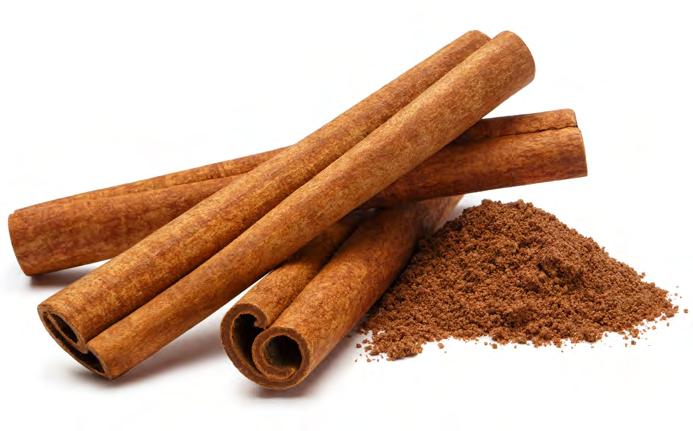 PHOTO BY ROMNEY CARUSO
PHOTO BY ROMNEY CARUSO
Cinnamon, in other words, is more than a single thing. Indeed, most spices have all sorts of variations. Curry, pepper, paprika — they each have special variations with subtle differences in their flavor profiles.

Cinnamon is one of the oldest spices that humans have ever known. The ancient Babylonians were trading it four and a half millennia ago. And it wasn’t always just a food flavoring. It was also a meat preservative — very important in the days before the Rouses meat department came along. The ancient Egyptians used it for mummifying their pharaohs and elites. You could burn it for ceremonies religious and otherwise. The stuff smells great.
But it was expensive. You are living in the golden age of cinnamon.
Today, you can dash off to Rouses and grab a jar of cinnamon in powder form or cinnamon sticks for a couple of dollars. In ancient Rome, cinnamon was fifteen times more expensive than silver. (Allegedly, after Nero slew his wife in a fit of anger, in her funeral pyre, he burned a year’s worth of the city supply of cinnamon to show how sorry he was. As a gentleman should.) Its high price was in part due to its scarcity, and in part due to its mystique.
For much of the history of the Western world, people generally did not know where cinnamon came from. Because Ancient Greece, for example, did not have the internet, if you did not know something, you just sort of guessed and believed the wrong thing your entire life. In this case, because only a rarified few knew where cinnamon actually originated, the legends around it were legion and fantastical.
Aristotle wrote of the “cinnamon bird,” who — according to those in the know — would fly to unknown places that humans could not reach, grab sticks of cinnamon, and build their nests out of the rare and wonderful spice. Inhabitants of this mysterious land would attach weights to the tips of their arrows, shoot them at treetops, and collect the sticks from downed cinnamon bird nests.

Herodotus, the ancient Greek historian, believed giant cinnamon birds lived in Arabia, and built their nests on the sides of steep cliffs. To get the cinnamon, Arabians would slay their oxen and lure the birds with heavy ox meat. The big birds would swoop down, grab the meat, carry it to their nests, and the weight would cause the whole thing to collapse. Traders would thus gather the downed cinnamon nests and send them to the west to improve the smells of meat and millionaires.
Pliny the Elder, a general and naturalist, thought Herodotus was an idiot, and said cinnamon growers and traders made up these stories to artificially inflate the price of cinnamon. No, Virginia, there is no cinnamon bird.
Old Pliny was correct. All the secrecy was because importers guarded their sources tightly to keep prices high, competition away, and traders secure. (Being a spice trader in ye olden days was hard, brutish work with peril around every corner, much like being a parent tasked with hiding all those gifts from the kids.)
Today, by far the biggest exporter of Ceylon cinnamon is Sri Lanka (the country was once called Ceylon). The biggest grower of cassia is China. Why do different countries grow different varieties? The answer is the climate. Each variation requires its own constraints on the highs and lows of temperature and humidity in order to survive. Ceylon cinnamon needs it to be hot and humid, and to never get too cold. Okay, so that sounds like Louisiana — so why don’t we grow it here? For Ceylon, it has to be really hot and humid. The U.S. Depart ment of Agriculture divides the nation up into “hardiness zones” to help farmers know what can grow where. Montana, where the snow is thick enough to film a Hallmark movie, is mostly Zone 3. Ceylon cinnamon, in comparison, grows in Zones 10 and 11. Most of Louisiana is in the parameters of Zone 9. We’re practically a winter wonderland compared to Ceylon cinnamon country.
The spice we call cinnamon comes from the inner bark of any number of cinnamon tree varieties. To get the cinnamon we know and love, the tree is pruned in such a way that shoots grow from it, and those shoots grow and develop a bark. Eventually, the bark is stripped from the tree, and the interior of the bark is separated from the exterior. The interior is dried and curls naturally into the shape and color of cinnamon sticks.
The reason cassia cinnamon is so popular here, and not Ceylon cinnamon or Saigon cinnamon, is that cassia cinnamon thrives in Zone 9, and thus is both a domestic product and also grown extensively in Asia and elsewhere. The differences between cassia, Ceylon, royal, and Korintje cinnamon can be found in various degrees of coarseness, different shades of brown, varying levels of bitterness and sweetness, and overall robustness of flavor. Cassia cinnamon is quite pungent, in a glorious holiday season way — it just hits you in the head when you walk into a bakery — whereas Ceylon and other cinnamon varieties are more subtle or slightly sweeter-smelling.
How, you might be wondering, is this spice so associated with Thanksgiving, Christmas, and wintertime generally? It goes back to its associations with immortality (the reason the Egyptians embalmed pharaohs), its preservative properties, and its high value. One of Job’s daughters in the Old Testament was named Keziah, a word that — you guessed it — traces its lineage to cassia cinnamon, which was very valuable. Multiple references in the Bible and holy texts of many religions help the association between the holidays and the smell.
Wintertime is obviously a time when preservatives would, histori cally, be necessary. And the season just brims with little acts of defiance over death. Just look around you. The reason there’s a Christmas tree in your house is that it is an evergreen. When the rest of nature is brown or leafless, there in your home is a vibrant green symbol of life and renewal. Over time, the associations between cinnamon’s scent and winter became inseparable.
For us, it is the smell of winter and cassia. Though your gingerbread man might be different from a Sri Lankan or Vietnamese gingerbread man, they share in their soft-baked hearts a common truth. You could say there is a whole family of cinnamons, and what are the holidays if not a time for family with a little dash of magic? It is what the cinnamon bird would have wanted.
With all due respect to the classic 70-year-old children’s board game, Candy Land, I believe I’ve solved the sweet mystery of where King Kandy, the ruler of the titular Candy Land, has been hiding all these years. It has nothing to do with Lord Licorice, Grandma Nut or Queen Frostine’s sea of ice cream — though, where we’re going, a peppermint forest might just spring up alongside a mountain of gumdrops. Around the holiday season, I would wager a guess that King Kandy takes up residence at the Grand Hotel in Point Clear, Alabama, where pastry chef Kimberly Lyons and her team of baking engineers carry on the tradition of building an exacting, awe-inspiring gingerbread replica of the property’s grounds each year — right down to the glittering, saccharine windowpanes and frosting-covered trees.
“Our gingerbread village is a replica of the hotel, so when you walk into the front doors of the main building, that’s the first thing you see. It's big. It takes up almost the whole lobby,” says Lyons. “It has a running train that goes through it, and it's just a really great thing for families to come in and experience. It's a tradition that started before I worked here, but I took on the
project and was able to transform it into something neat and different.”
Lyons is always finding new ways to add a fresh sense of whimsy and intricacy to the creation, while also making sure her trusty dog, Nitro, can make a cameo within the gingerbread landscape. “We have an ‘I spy’ game that I've created over the years to really give the kids an opportunity to search for things [inside the gingerbread village] because I like to hide a lot of details in it. We spend a lot of time planning and working on it. Nitro’s in there every year, and there’s also usually a unicorn on there. We'll hide little rubber duckies in the lagoon. Back in 2020, we did snowmen that were wearing masks to reflect the pandemic. We have some cats that like to hang around our front building, so I've hidden cats in there before. Of course, reindeer, Santa Claus … really anything that is going to be fun for the kids to search for.”
The construction process is not only a creative one, but a logistical feat that requires an “all hands on deck” approach from departments throughout the hotel. The pastry team started baking the gingerbread bricks in September this year, and tradition ally moves the assembly process to a dedicated ballroom in October until it’s time to unveil the creation in the lobby on Thanksgiving Day.
“We make all of the bricks and do some of the smaller stuff in the bakeshop itself, and then about a month before it goes on display, we move into one of our smaller ballrooms and take over that ballroom for about a month. We just go in there and get down to creating the grass, the gravel, the water, adding all


those fun details, the candy—everything. It's great, too, because it's not always just the pastry cooks working on it. Last year, we had so much help from all the different departments. They came together and really helped build it. Each department took their own building and decorated it, and it came together to create this whole display. It was really beautiful. It’s definitely a bonding moment for the teams, as well.”
If you’re feeling sweetly ambitious and want to take a crack at building a minia ture-sized version of your own house out of gingerbread this year, Lyons says the ultimate secret to a sturdy, centerpieceworthy pastry construction is all about the icing: the stiffer, the better—no runny stuff allowed.

“It is all about the icing for me. If you have a good royal icing that holds its shape when you pipe it, you're set, because that royal icing is going to harden pretty quickly and work like a cement for you. Sometimes, though, those icings you get [pre-packaged] are too thin, and your house is never going to stay together with a runny royal icing.”
And even though Lyons and her team spend months handcrafting thousands of individual bricks to build their ginger bread village at the Grand Hotel, she suggests leaving the hyper-detailed, structurally based baking to the pros. “I always recommend just buying a ginger bread kit—it’s so easy. It can be difficult to make the gingerbread pieces at home, so buy the kit, but make your own royal icing. That way, you’re going to have the best time.”
After all, who would know better than the queen of holiday gingerbread herself?

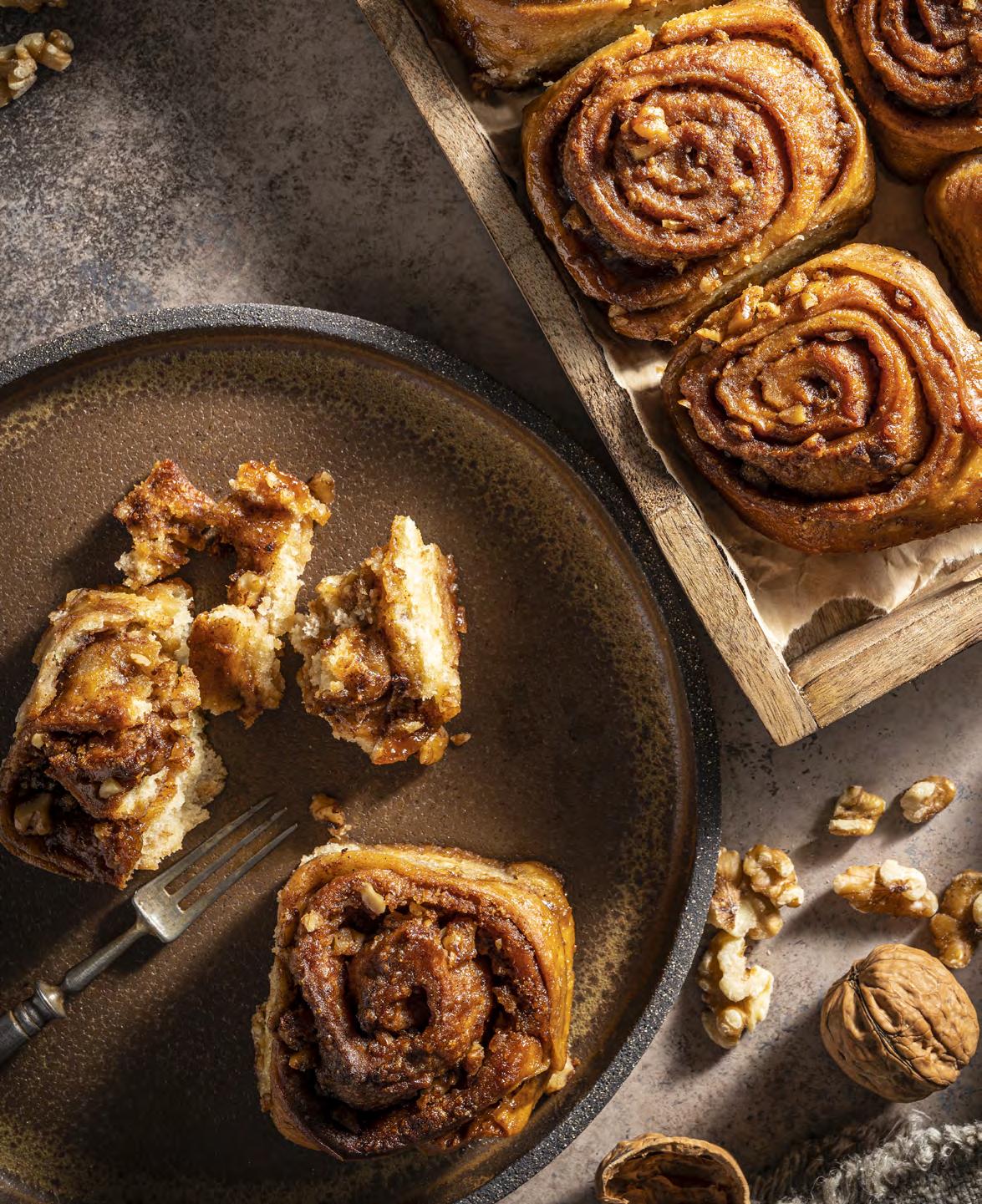
When Mark Mayer’s grandparents emigrated from Nazi Germany in 1936, they arrived in America knowing just two people and unable to speak English. In those days, if you were Jewish and trying to get into the United States, you needed a sponsor — someone who would commit to ensuring you had clothes, a roof over your head and the basic necessities of life. By sheer happenstance, two of Mark’s uncles had immigrated to New Orleans years earlier, and started a sock factory. They sponsored Mark’s grandparents — Hilda and Erhard — and Mark’s father, the couple’s six-year-old son, Peter.
It was very much the traditional immigrant story. They cried at the sight of the Statue of Liberty, were processed through Ellis Island and, upon settling in New Orleans, sought a better life and brighter future. Employment did not come easy, however. Erhard had a hard time finding work without the ability to speak English. His wife Hilda, however, spoke a language that transcended words: She was a gifted baker.
“My Oma had remarkable baking skills and set out immediately to feed the family,” said Mark, who is the chairman emeritus of PETER MAYER, an advertising firm in New Orleans. “She made unbelievable German specialties: plum cake, cheesecake, pecan cookies — there was always an incredible smell coming out of her kitchen.” Hilda began baking professionally from her home almost immediately. “The family quickly became middle class because my grandmother had such a strong clientele — people would buy from her every single week.” It was something of a whole-family operation that she maintained throughout her adult life and into her 70s. Most famously, she made schnecken, a German sweet roll similar to a cinnamon roll.
“It was loaded with butter. She would coat the dough with cinnamon, pecans, butter, a lot of brown sugar and caramelized sugar, and roll everything up in a long tube. She would then chop it into discs about the size of hockey pucks.” In special baking tins she had brought with her from Germany, she put butter

on the bottom, added the discs of dough, and topped them with yet more pecans and sugar, then into the oven they’d go. “Even today, when I go into a bakery, and there’s that heavy buttery pecancinnamon smell, it just transports me right back to Oma’s kitchen. It was just unbelievably good — the whole neighborhood smelled like schnecken, down the entire block.”
Hilda was self-taught, a “touch baker” as Mark describes it. “She did not have any recipes. None. Zero. She could feel the dough and be able to tell you if it needed more flour, if it was dry enough…. She could tell when it was ready to bake just by how it felt. Every thing was in her head, and she could make anything — and these were very complicated recipes.”
One of Hilda’s secrets: lots and lots of butter. “Schwegmann’s [the defunct New Orleans grocery store chain] always had discounts on butter, 29 cents a pound,” Mark recalls. “There was a two-pound limit per person.” Hilda’s solution? Family. “My parents and all the grandkids would have to stand in line, each with two pounds of butter, so she could come through with 12 pounds total, which is what she needed to get her baking done.”
The Mayer home had two enormous freezers, a huge kitchen and a room where Hilda assembled the boxes for her pastries. “Everything was done from her house,” Mark says. “People would call and place an order, and come by to pick it up. The grandkids would help Oma assemble the orders for the day, put the boxes together, put stuff in the right boxes, and tie the boxes off with string while she watched.”
Mark describes the life of his grandparents and father as a typical immigrant story. “My father — from the tender age of six — became the interpreter for the entire family, translating official things into German for Opa and Oma when they would get mail.” Slowly, Erhard learned English and eventually got a job as a traveling salesman of women’s clothing. (In Germany, he had been a wine merchant.)
Though his grandmother has long since passed away, Mark’s aunt, Ann, was determined not to let the schnecken recipe die with his grandmother, so she sat with Hilda and wrote down the recipe. Alas, Mark says, something was lost in translation. “Some unmeasurable element of my grandmother’s skill died with her. While the recipe exists on paper, all of us have tasted the results and declared it inferior to the original. It cannot be replicated, a recipe by this touch baker who had magic in her fingertips.”
ARROW-CIRCLE-RIGHT Camp Walden is an all-girl summer camp in Denmark, Maine, about an hour outside of Portland. You may remember it as the summer camp where Annie James and Hallie Parker — both played by Lindsey Lohan — met in the 1998 remake of the original 1961 film, The Parent Trap
I went to Camp Walden for five summers. We lived in bunks with a dozen or so campers in each, plus two counselors. There was no isolation cabin, like in the 1998 movie. The bunks were set in a horseshoe around a pine-needled knoll called the Grove.

Mornings began with the ring of an old-fashioned bell; evenings ended with campfire songs and the traditional “Day is done, gone the sun…” of “Taps.” In between, we played tennis and softball, rode horses, swam, canoed and sailed on the lake (no fencing, though). There were overnight trips, three each summer, in Maine and New Hampshire, where we went mountain climbing, which was a big deal for a girl from New Orleans. At night we watched old Walt Disney movies — including the original Parent Trap, starring Hayley Mills — in the Ark, where we put on Saturday night bunk shows.
Walden was run, at the time, by Helen Herz Cohen, known as Miss Herz, who succeeded her aunt, one of the founders, as Camp Director; Miss Herz later became the owner of Camp Walden. Every Sunday, we had schnecken (pronounced shnek-uhn), which is like a cinnamon roll, but on steroids. Schnecken were very popular throughout Germany, Austria and Hungary, where many bakers happened to be Jewish; recipes were brought to America by Germans and German Jews in the 19th century. It is made with a rich, sweet, yeast dough that’s coiled and baked, open side up, in gobs of butter and cinnamon sugar. Walden’s version was topped with raisins and chopped nuts.
I can still taste Walden schnecken 30 years later. Which is why, when it came to actually re-creating it for this issue — even with the recipe a Waldenite provided me, and recipes I found online — I knew that something wasn’t right. Our shnecken wasn’t sticky and gooey enough.
Before I said “Shneck It!” and gave up, I contacted my sister Courtney, who was a few bunks behind me at Walden, and who still remembers every word to every song we sang at Walden, including one about schnecken (“Schnecken. We love our schnecken. We eat it every Sunday morn …”). If anyone could remember it, it would be Courtney, so I called her to see if she could go from recollection to recipe.
She made a few adjustments to the printed Walden recipe, and added more butter and cinnamon to make the rolls gooier. She also suggested a shortcut: Use tubes of store-bought cinnamon dough instead of making your own, and pitch the included icing. Well, Courtney is younger; maybe her memories are fresher, and maybe that’s why she nailed it — because it tasted like Sunday mornings in Maine.
— Marcy Nathan, Creative DirectorMakes 10 if using Grands, 8 if using small rolls
The “Grands” roll out very easily and are best suited to this recipe. You can use the small rolls, but they will not roll out as easily or cleanly. If you use the small rolls, do not cut them in half before rolling out.
1 tube Pillsbury Grands Cinnamon Rolls (discard icing)
1 cup butter, melted, plus more if needed
½ cup finely chopped pecans
6 tablespoons brown sugar
½ cup raisins
Preheat oven to 350°F.
Melt 4 tablespoons of the butter, and pour it in a glass baking pan. Set the pan aside.
On a cutting board, unroll the cinnamon rolls one at a time and cut each in half. (Do not cut in half if using small cinnamon rolls.)

Melt 4 more tablespoons of the butter, and brush inside all of unrolled dough with the melted butter. Then, spread pecans, brown sugar and raisins on top of the buttery dough. Roll each dough back into a bun shape, and place on top of the melted butter in the glass baking pan, packing them closely in the pan.
Lightly brush the tops of all rolls with remaining melted butter, melting more if needed, and sprinkle lightly with brown sugar. Place in preheated oven and bake for 20 minutes.
Visit www.rouses.com for a traditional (complicated) schnecken recipe.
 PHOTO BY ROMNEY CARUSO
PHOTO BY ROMNEY CARUSO

A major part of the Jewish festival of Hanukkah is the story of the oil that miraculously lit the menorah in the holy temple in Jerusalem for eight full days. That’s why the Jewish holiday tradition calls for fried foods, like latkes (potato pancakes) and sufganiyot (jelly donuts). Babka — and especially chocolate babka — is also served by many families at Hanukkah. Babka is a dense cake made with cinnamon and sugar that looks like bread; it often has streusel on top. The festive cake originated in the Jewish communities of Poland and Ukraine; chocolate babka is a mid-century American Jewish invention.
For the Cake:
½ cup granulated sugar
2 teaspoons salt
2⅓cups all-purpose flour, sifted
2 teaspoons yeast
½ cup water
3 tablespoons butter, softened
3 eggs
For the Filling:
5 tablespoons unsalted butter, softened and divided
8 ounces bittersweet chocolate, chopped and divided
¼ cup granulated sugar
HOW TO PREP:
Combine sugar and salt. Set aside.
In a stand mixer fitted with a dough hook attachment, combine flour, yeast, water, butter and eggs. Mix at
with pan spray. Cover with plastic wrap and refrigerate overnight.
Remove dough from refrigerator and let rest at room temperature for 1½ hours.
Place dough on floured work surface and cut in half. Flatten each halfdough and roll each very thinly into an approximately 9” ×12” rectangle. Spread 2½ tablespoons of the softened butter on each half of the dough, leaving a half-inch border all around. Sprinkle 4 ounces of the chocolate evenly over each buttered half, then sprinkle each with 2 tablespoons sugar.
Roll the first half up like a jelly roll down the short side. Repeat with other half. The two should be similar in length and circumference.

Place the two rolls side by side and trim the ends so they are smooth and even in length. Cut the first rolledup log in half lengthwise, then twist the two cut halves into one twisted dough. Repeat with other rolled-up log.
Place each twisted loaf in a greased loaf pan and let rise 2½ hours.
When you’re ready to bake, preheat oven to 350°F.
When oven is preheated, transfer loaf pans to oven and bake until a toothpick goes into the cakes without any resistance and comes out clean, around 40 to 50 minutes.
Transfer each loaf to a wire rack to cool completely before serving.
This year, Hanukkah begins Sunday, Dec. 18, and ends the evening of Monday, Dec. 26.
We’ve given Mother Nature’s masterpiece a new look! Enjoy all the benefits of naturally high alkaline evamor® water in a sleek new bottle. With a naturally occurring pH of 8.8-9.1, evamor water continues to flow from the same single source – a rare aquifer deep in the Earth, directly under our bottling facility – delivering pristine, smooth-tasting water that’s untouched by the modern world until you take a sip.


Available in 20 oz., 32 oz. and 64 oz. sizes. Learn more at evamor.com

They are a snack-time favorite everyone can enjoy and the perfect companion to add a little cheesy, crunchy excitement to your meals. Add Goldfish Cheddar crackers to soups, sprinkle them on salads, or simply serve as a side to your lunchtime sandwich.
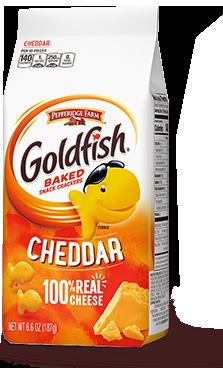


It’s the little things that make food taste special. We believe in doing things right, and we just happen to love it. Go for the handful!














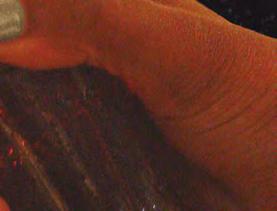



































 PHOTOS BY ROMNEY CARUSO64 ROUSES WINTER 2022
PHOTOS BY ROMNEY CARUSO64 ROUSES WINTER 2022
OF THE MONTH: NOVEMBER
Serves 6-8
½ pound green onion smoked sausage, cut into 1-inch rounds
¾ cup vegetable oil
¾ cup flour
2 cups chopped yellow onion
½ cup chopped bell pepper
½ cup chopped celery
1 teaspoon salt

1 teaspoon Cajun seasoning
2-3 quarts turkey stock (see recipe on next page)
2 tablespoons dried thyme
ARROW-CIRCLE-RIGHT We kicked off our Year of Gumbo with our Fall 2022 magazine. This issue we feature a leftover Thanksgiving Turkey gumbo, a Christmas Turduchen gumbo, and a Black-Eyed Pea gumbo with greens and pork for New Year’s Day. Follow along @rousesmarkets social media and search #gumbolife for gumbo stories, recipes and more every month of the year.
2 tablespoons dried oregano
3 dried bay leaves
¼ pound leftover turkey, roughly chopped Steamed rice, for serving Fried turkey necks, for serving (see recipe on next page)
In a large Dutch oven over medium heat, brown the sausage; transfer to a plate when done and set aside.
In the same pot, prepare a dark brown roux with the oil, flour and sausage drippings that remain in the pot, slowly shaking the flour over the oil with one hand while whisking with the other hand. Continue to whisk until the roux darkens to a glossy, dark red-brown, around 15 to 20 minutes.
Add onion, bell pepper and celery, and season with salt and Cajun seasoning, stirring to coat. Add the cooked sausage back to the pot and cook, stirring constantly, until sausage is reheated, about 5 minutes.
Gradually add the stock one ladleful at a time, stirring constantly to combine. Add the thyme, oregano and bay leaves and simmer, uncovered, over medium-low heat, stirring and skimming every 20 minutes, until the flavors have melded, for at least 1 hour.
Stir in the turkey meat just before serving and cook until warmed, 3 to 5 minutes. Remove the bay leaves and discard.
Serve over steamed rice, garnished with a fried turkey neck.

TURKEY STOCK
Makes 2-3 quarts
Leftover bones, meat, skin and carcass from a roasted turkey
1 stalk celery, roughly chopped
1 large onion, peeled and quartered
4 quarts water (or enough to cover carcass)
2 teaspoons salt
1 tablespoon black peppercorns
4 bay leaves
Place turkey bones, meat, skin and carcass in large stockpot. Add celery, onion, water, salt, peppercorns and bay leaves. Bring to a boil. Reduce heat to medium and simmer, uncovered, stirring occasionally and scraping bottom of pan to loosen any bits of meat, for at least 2 hours.
Remove from heat and skim any fat that has risen to the surface. Strain through a large colander into another pot.
Use stock immediately or freeze in quart-size containers.
Makes 4 servings
Turkey necks are dark meat, so they stay flavorful and juicy when smoked, smothered, stewed, fried, or when prepared in a seafood boil or gumbo.

4 whole turkey necks
½ yellow onion, chopped
1 tablespoon Rouses Down the Bayou seafood boil
5 cups water, for boiling Salt and pepper
3 cups all-purpose flour
Vegetable oil, for frying
Place turkey necks, onion and seafood boil in water on stove and simmer for an hour. Remove from heat, allow to cool.
Cut turkey necks into 4-inch pieces. Season liberally with salt and pepper, and sear on all sides in a large cast-iron pot with a lid. Remove from pot, roll neck pieces in flour, and fry them in 350°F vegetable oil for approximately 35 minutes, or until heated through.
Serves 12
2 duck breasts
Cajun seasoning
1 pound fresh green onion smoked sausage, cut into bite-sized slices
¾ cup vegetable oil
1 cup all-purpose flour
2 cups chopped yellow onion
1 cup chopped bell pepper
1 cup chopped celery
2 tablespoons chopped garlic
1 Rouses Rotisserie Chicken, deboned and shredded
1 pound leftover turkey, shredded
4 (32-ounce) containers unsalted chicken stock or leftover Thanksgiving turkey stock
4 tablespoons Cajun Power® Garlic Sauce
Leftover dirty rice, for serving
Leftover cornbread dressing, for serving
Liberally season duck breasts with Cajun seasoning. Place them skin side down in cast-iron skillet and cook on medium-low for 10 minutes, until fat starts to render.
Remove breasts and remove skin from
breasts. Return skin to skillet and let simmer for another 10 minutes to render fat, turning occasionally. Remove skin and discard, and pour rendered fat into a large cast-iron pot. Add duck breasts and cook for 10 minutes on each side. Remove duck breasts. Slice when cooled.
In same skillet place cut sausage and cook for 10 minutes to render juices from sausage. Remove sausage and pour rendered oil into cast-iron pot; this should yield about ¼ cup of oil. Add vegetable oil to duck and sausage oil rendering. When all oil is placed into pot, it should be 1 cup exactly; add additional oil to make it come up to 1 cup if it’s short.
Slowly shake the flour over the oil in the castiron pot with one hand while stirring with the other hand. Stir constantly for about 30 minutes until a dark, rich, chocolate color is achieved. Reduce the heat to medium and stir the onion, bell pepper, celery and garlic into the roux. Stir constantly and brown the vegetables for about 15 minutes.
After vegetables are browned, add turkey, duck, chicken and sausage, and stir for 10 minutes at a simmer. Add chicken stock and Cajun Power Garlic Sauce. Let boil for 10 minutes, stirring constantly. Reduce to low heat. Cover and cook on low for 1 hour. Season with salt and pepper, and serve with dirty rice and cornbread dressing.
GUMBO OF THE MONTH: DECEMBERA turduchen is a deboned turkey stuffed with boneless duck and chicken and, in our case, two helpings of fresh sausage or dressing (or both). You can order a turduchen in our Butcher Shop. We also make a fresh turduchen sausage.
ARROW-CIRCLE-RIGHT
ARROW-CIRCLE-RIGHT On New Year’s Day, people all over the Gulf Coast eat some form of blackeyed peas and cabbage to invite good luck and prosperity in the coming year. Though some say the pea (a seed) is to remind us of new life and new beginnings, the most commonly held notion is that the round peas are symbolic of coins. The cabbage is meant to symbolize, well, green — the color of our paper currency. We used kale for this recipe, but almost any greens will do. Kale, mustard greens, collard greens and turnip greens are all part of the brassica oleracea family, which makes them relatives of cabbage.
Makes 6-8 servings
WHAT YOU WILL NEED:
¾ cup vegetable oil
¾ cup all-purpose flour
1 cup diced yellow onion
½ cup diced green bell pepper
½ cup diced celery
2 tablespoons chopped garlic
1 cup chopped smoked sausage or andouille
3 quarts chicken stock
1 cup black-eyed peas, cooked and drained
1 bunch kale or greens, washed and sliced into ribbons
1 tablespoon salt
1 tablespoon ground black pepper
Hot sauce
Steamed rice, for serving
In a large pot, heat the vegetable oil over medium-high heat. Slowly whisk in the flour
ARROW-CIRCLE-RIGHT Since Lucius Hamilton Hayward founded L.H. Hayward and Company in 1923 to sell red beans in the French Market in New Orleans, it’s been family owned and family operated.
and continue whisking until the roux begins to turn brown, 15 to 20 minutes.
Add the onion, bell pepper, celery and garlic to the roux and cook, stirring, until vegeta bles are softened, about 10 minutes. Add the smoked sausage and stir. Add the stock and bring to a simmer, stirring occasionally. Simmer over medium-low heat, skimming occasionally, until flavors meld, at least 45 minutes.
Stir the black-eyed peas and greens into the gumbo. Return to a simmer, then season with salt, pepper and hot sauce. Serve with steamed rice.
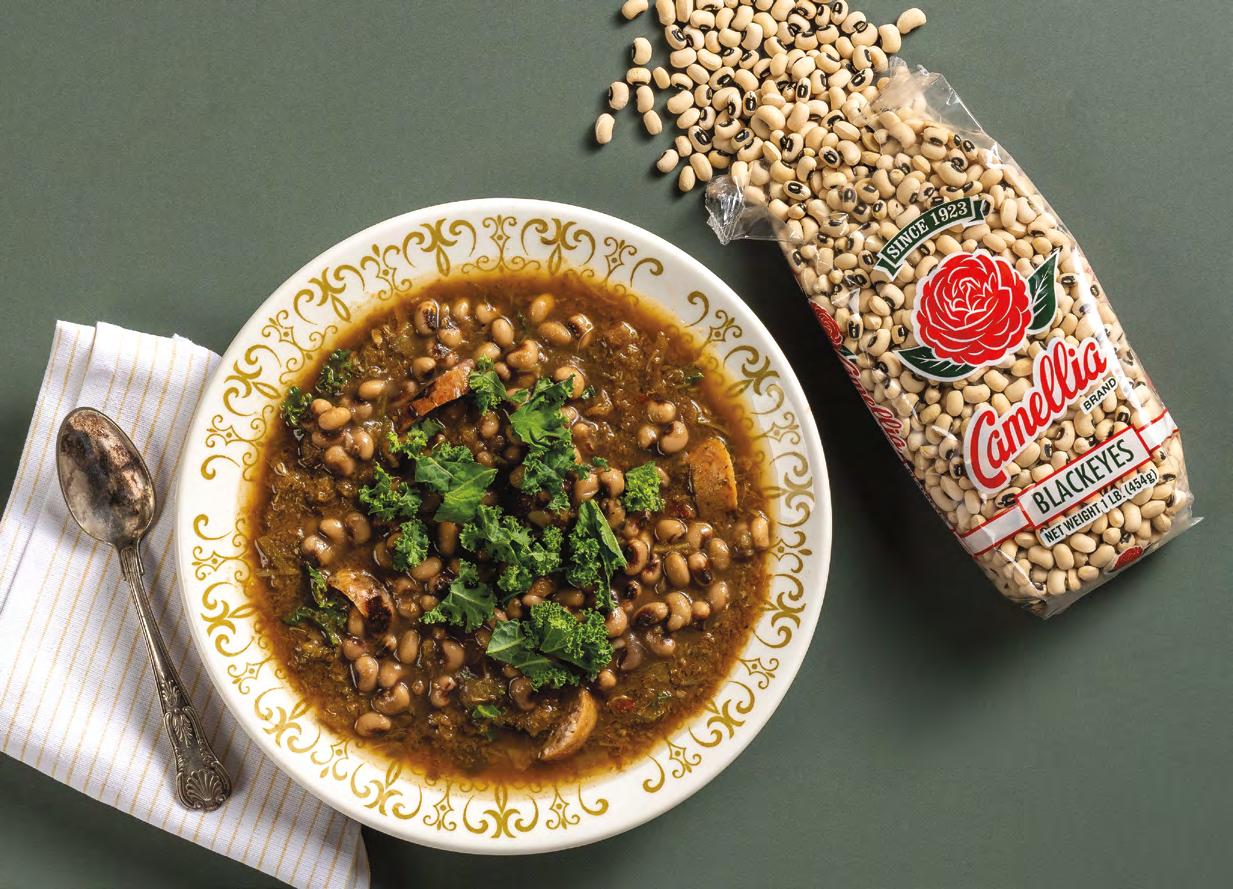 GUMBO OF THE MONTH: JANUARY
GUMBO OF THE MONTH: JANUARY







 By Sarah Baird
By Sarah Baird
No matter where you’re from, when the calendar flips over to a new year, it’s time to break out some triedand-true traditions to attract the maximum amount of good fortune for the upcoming 365 days. In Spain, this means speed-eating 12 grapes (one for each time the clock chimes) at the stroke of midnight. In Iran, celebrants snack on kuku sabzi, an herb-heavy frittata, for abundance and happiness during Nowruz, the Persian New Year. And in the American South, you’d be hard-pressed to find a superstitious household where someone isn’t cooking up a sizeable batch of blackeyed peas and collard greens on Jan. 1.
Across East and Southeast Asia, where countries follow the lunisolar calendar, the start of the symbolic new year officially begins when the new moon arrives in late January or early February. Known as the Lunar New Year, this seismic shifting to a fresh, anything-can-happen year is honored and celebrated with widespread revelry — and plenty of lucky rituals. In China, the Lunar New Year means festooning homes, businesses, and everywhere in between
with auspicious shades of red: Red-andgold fireworks crack, red lanterns sway in the breeze, and children open small red envelopes filled with money as a blessing from their elders. In Vietnam, the Lunar New Year, known as tet nguyen dan (or Tet for short), finds multiple generations gathering to cook banh chung (sticky rice cakes with rich pork belly and mung beans) and candied coconut ribbon to usher in a fortunate, family-centered new year. And for the Taiwanese, pineapple cakes and white turnips are the good-luck foods that mark the passage into the next annual cycle and hope of coming spring.
The Lunar New Year in China also marks the annual transition between the 12 zodiac signs, with a new corresponding animal — possessing unique personality traits — taking over yearly. Much as in Western astrology, people are said to possess characteristics of the Chinese zodiac sign under which they were born, and whether you’re an affable, hardworking Pig or a philosophical, serious Snake, it’s always illuminating to put a finger on potential reasons we behave, feel, and believe certain ways.

Outlined below are the 12 Chinese zodiac signs, their personality traits, and a lucky food suggestion for the upcoming year. After you find your sign, if you’re looking to really swell your good fortune during the Lunar New Year, there’s also advice on how to create a Chinese-inspired dish with each ingredient that incorporates traditional, lucky Lunar New Year preparations with your sign’s uniquely fortunate food. (If not, there are some traditional American holiday menu ideas proposed as well.)
Welcome to the Year of the Rabbit in 2023, and xīn nián hao!
Born: 1936, 1948, 1960, 1972, 1984, 1996, 2008, 2020
The first sign of the Chinese zodiac cycle, thanks to their cunning ways, those born in the Year of the Rat are quick-thinking, social creatures who enjoy rubbing elbows with plenty of acquaintances (the cocktail party circuit was built for them) but only show their generosity with a select few. Are Rats a little opportunistic? Sometimes, but their deeply rooted sincerity helps keep them in check. “The charm and innovative personality of the Rat is legendary,” write Theodora and Laura Lau in The Handbook of Chinese Horoscopes (9th Edition). “On the surface, some Rats may appear reserved, even placid, but they are never as quiet as they may seem. Something is always going on inside that sharp mind.”
ARROW-CIRCLE-RIGHT DISH TO TRY: During the post-holiday lull between Christmas and New Year — when glittery wrapping paper still carpets the house — nothing is simpler and more soul-warming than a classic 40-clove garlic chicken roasting in the oven. If you’re looking to grow your wealth in 2023, start practicing making spring rolls — specifically, a garlic-heavy version with bean sprouts, coriander and spring onions. The lucky saying for eating spring rolls during the Lunar New Year is hwung-jin wan-lyang , which translates to “a ton of gold,” and repeating this while crunching into a perfectly golden, garlicky spring roll will assuredly help usher in a year of prosperity.
Born: 1937, 1949, 1961, 1973, 1985, 1997, 2009, 2021
If you have someone in your orbit who is always willing to go the extra mile for a loved one — a trustworthy, hardworking and dependable person — I’d wager a bet that they were born in the Year of the Ox. Diligence and stability are the calling cards of Oxen folk, which probably comes as no surprise, thanks to their ties to agriculture and the earth. They’ll hold steadfast to their commitments with an honest, quiet determination that’s rare in our modern era.

ARROW-CIRCLE-RIGHT LUCKY FOOD: Eggplant
ARROW-CIRCLE-RIGHT DISH TO TRY: Eggplant could grace your holiday menu as the showstopping ingredient in a vegetarian-friendly Provencal tian (a type of gratin) to impress the in-laws, or in a big bowl of cozy, tomato-rich pasta alla Norma to enjoy while you’re wrapping presents with friends. On the other hand, you could break out the wok to make red-braised Chinese eggplant, a chile-forward, garlicky vegan dish where thick slabs of eggplant serve as (delicious) sponges for a sticky-umami sauce. It works well as a crowd-pleasing main course or a potluck sleeper hit, all while bringing everyone a taste of good luck with its Lunar New Year-approved red hue.
Born: 1938, 1950, 1962, 1974, 1986, 1998, 2010, 2022
There’s no one more dynamic — for better or worse — than a person born in the Year of the Tiger, with enough fiery adventurousness, vigorous energy and rebellious spirit to lead a revolution. Despite being honest to a fault and just a tad impulsive, people are always drawn to Tigers for their underlying sense of justice and ability to fight for what they believe in. Beneath all that daring and bravado, though, lies an undercurrent of cuddly sensitivity, which Tigers should take great care to foster through close relationships.
ARROW-CIRCLE-RIGHT LUCKY FOOD: Corn

ARROW-CIRCLE-RIGHT DISH TO TRY: A heaping helping of corn pudding, or a butter-dappled hunk of crumbly cornbread would fit in well on your holiday plate, sure. But why not mix it up by making tiger prawns with sweet corn and chiles for dinner on a night you’re marathoning Hallmark Christmas movies?
Born: 1939, 1951, 1963, 1975, 1987, 1999, 2011, 2023
Oh, earnest, deep-feeling, artistic rabbits, 2023 is a year that’s in your sign, which means that you might experience quite the rollercoaster ride of highs and lows (“fan tai sui” ) throughout its course. Nevertheless, your gentle kindness and sociability will ensure that even on the most ho-hum days, you understand that there’s grace to be gleaned from all situations — just make sure not to give in to your overly-analytical side.
ARROW-CIRCLE-RIGHT LUCKY FOOD: Beef
ARROW-CIRCLE-RIGHT DISH TO TRY: Go all out with tteokguk — “good luck Korean rice cake soup” — which comprises fall-off-the-bone brisket simmered with scallions and ginger. It’s traditionally eaten in Korea to begin the new year. And if a special occasion soup doesn’t speak to you, there’s always tried-and-true beef Wellington or prime rib to fall back on as a celebratory centerpiece.



Born: 1941, 1953, 1965, 1977, 1989, 2001, 2013, 2025
The deepest thinkers in the Chinese zodiac, Snakes are known for their wise-beyond-their-years air, enigmatic nature and smooth sophistication. Those born in the Year of the Snake tend to trust their own instincts above the recommendations of others, and have a calm and orderly approach to dealing with even the stickiest issues. Be warned, though: Snakes tend to be somewhat distrustful and mysterious, so don’t be surprised if you’re always left wondering, “What do they actually think about me?”
ARROW-CIRCLE-RIGHT LUCKY FOOD: Almonds
ARROW-CIRCLE-RIGHT DISH TO TRY: You’d be hard-pressed to think of a sweet snack that smells more like the holiday season than sugar-crystalized, cinnamonscented candied almonds (known in German as gebrannte mandeln). If you’ve gone overboard on the baking spices this season, though, let almonds be the star of the show in a big batch of Chinese almond cookies, which use whole almonds, almond flour, and almond extract, and are said to resemble coins for good luck.
Born: 1942, 1954, 1966, 1978, 1990, 2002, 2014, 2026
If a free-spirited, ultra-sporty, dream-chasing partner is who you’re searching for, then focus your dating apps in on someone born in the Year of the Horse. “A person born in the Horse’s year will be cheerful, popular and quick-witted although [their] changeable nature may cause them to be hot-tempered, rash and head-strong at times,” write Lau and Lau. “Earthy and warmly appealing, [they] are very perceptive, talkative … and are noted for their love of sports, outdoor activities and fondness for animals.”
ARROW-CIRCLE-RIGHT LUCKY FOOD: Sweet Potatoes
ARROW-CIRCLE-RIGHT DISH TO TRY: It’s said that the number of dumplings you’re able to eat during the Lunar New Year will predict how much money you’ll be making in the coming year, and if you’re gobbling down money bag dumplings, expect your riches to flourish. Unlike traditional, crescent-moonshaped dumplings, money bag dumplings resemble satchels of coins, and sweet potatoes make for the perfect golden-hued filling. If dumplings aren’t your thing, incorporate your lucky food first thing in the morning with a gooey plate of sweet potato cinnamon rolls.
Born: 1943, 1955, 1967, 1979, 1991, 2003, 2015, 2027

Gentle and compassionate, Sheep are marked by one major personality trait: their sensitivity. The most peaceful and mildmannered of all the Chinese zodiac signs, people born in the Year of the Sheep are drawn to both creative pursuits and helping others — even better if they can find a way to combine the two. Empathetic Sheep adore spending time with children and will always give everyone the benefit of the doubt (for better or worse).
ARROW-CIRCLE-RIGHT LUCKY FOOD: Mushrooms

ARROW-CIRCLE-RIGHT

DISH TO TRY: Shitake mushrooms symbolize prosperity in Chinese culture, so you can maximize your good fortune for 2023 by whirring the ‘shrooms into a creamy soup to sip from a thermos while oohing and aahing at holiday lights. However, I’d suggest looking toward the future — and doubling down on good luck — by incorporating shitakes into a traditional Lunar New Year dish: longevity noodles. A celebratory staple, the spongy, stir-fried noodles are never broken by the cook (ever!) and if you can eat the noodles without biting in the middle, well, that’s even more auspicious. Long noodles, long life.

Born: 1940, 1952, 1964, 1976, 1988, 2000, 2012, 2024 The only mythical creature to come fire-breathing into the Chinese zodiac line-up, people born in the Year of the Dragon are as captivating, charismatic and confident as the powerful creature that represents them, easily achieving leadership positions thanks to a great deal of ambition, intuition and a little bit of luck. Dragons are widely considered the most auspicious of the signs. Because they’re often so career-focused, dragons tend to neglect their health, so it’s critical that they take time to recharge and find balance. (As a Dragon myself, I’m still trying to take my own advice.)

ARROW-CIRCLE-RIGHT DISH TO TRY: For a more classic spinach-based dish, you can’t go wrong with a good old-fashioned creamed spinach or legendary River Road Recipes cookbook staple, Spinach Madeleine. But if you’re trying to turn a corner into a less cheese-filled existence in the new year, spinach dumplings with tofu and a cup of green tea are a surefire way to deliciously triple your healthy goodwill. Just make sure to arrange your dumplings in lines instead of circles on the plate; circles of dumplings indicate that a person’s life will spiral and never go anywhere during the new year.
Born: 1932, 1944, 1956, 1968, 1980, 1992, 2004, 2016, 2028 Witty, clever and predisposed to just a little bit of mischief-making, people born in the Year of the Monkey are some of the most intelligent in the entire zodiac. Monkeys love to make others laugh (no surprise there!) but can have an impatient streak
when those around them can’t keep up with their ever-racing train of thought. Since monkeys love to eat peaches — and, in China, peaches are associated with longevity — those born under the sign of the Monkey are expected to have long, fruitful lives.
ARROW-CIRCLE-RIGHT LUCKY FOOD: Black Beans
ARROW-CIRCLE-RIGHT DISH TO TRY: In Cuban households, no Christmas Eve is complete without frijoles negros , the flavor-packed, slow-cooked black beans with an aroma so enticing you’ll be itching to know the secret ingredient in the sofrito. But if you’re looking for a condiment that can be used time and again in the coming year (and that makes a gourmand-approved gift!) consider making your own Chinese black bean sauce. These fermented “black beans” — which are actually black soybeans, called douchi — are easy to whip up into a pungent, spicy, tongue-tingling sauce that goes with everything from seared bok choy to roasted whole fish, a Lunar New Year food symbolizing abundance.



Born: 1933, 1945, 1957, 1969, 1981, 1993, 2005, 2017, 2029
“The Rooster is the Don Quixote of the Chinese cycle. A dauntless hero, he is the most misunderstood and eccentric of all the signs,” write Lau and Lau. “Outwardly, he is the epitome of self-assurance and aggression, but at heat, he can be conservative and old-fashioned.” With a bent toward perfectionism and an unrelenting seriousness about, well, everything, those born in the Year of the Rooster are something of a paradox: quick to criticism while in the public sphere, but in need of constant reassurance when roosting at home with their tight-knit family. If you’re a Rooster, it would be wise to keep your feather-ruffling cockiness in check..
ARROW-CIRCLE-RIGHT DISH TO TRY: Rice pudding laced with nutmeg and dappled with currants has a decidedly Victorian Christmas feel if you’re trying to do your best A Christmas Carol cosplay, or you could make eight treasure rice — the auspicious Lunar New Year version of rice pudding. A popular dish in both China and Taiwan, eight treasure rice adorns glutinous (sticky) rice with eight different types of colorful, jewel-like dried fruits and nuts and fills the center of the dome-shaped, showstopping dish with red bean paste. The number eight in Chinese has become a lucky touchstone because it sounds like the word for “thriving in business” while each of the “treasures” — from dates and jackfruit to walnuts and dried pears — comes with its own unique good fortune.
Born: 1934, 1946, 1958, 1970, 1982, 1994, 2006, 2018 “Loyalty” is the word flashing in neon above the heads of everyone born in the Year of the Dog, and if you’re in their inner circle, there’s nothing that they won’t do to help make your life just a little bit easier. Affectionate, friendly and sincere, Dogs are sensitive to their surroundings and aren’t afraid to speak their mind — even if it clashes with those outside of their intimate pack.
ARROW-CIRCLE-RIGHT LUCKY FOOD: Ginger
ARROW-CIRCLE-RIGHT DISH TO TRY: Instead of dips and crudité, offer up sweet well wishes at your holiday celebration with a “tray of togetherness”: an eightcompartment serving platter filled with dried fruits, candies and nuts that traditionally welcomes guests to Lunar New Year gatherings. Fill your tray with plenty of candied ginger (for longevity), dried kumquats (for prosperity), peanuts (for good health), dried pineapple (for success in business) and whatever other blessings you’d like to shower upon your loved ones in the forthcoming year. Opting out of the tray of togetherness? Don’t be afraid to tuck additional bursts of ginger into your heirloom recipes, like candied sweet potatoes, pumpkin pie and ham glaze.
Born: 1935, 1947, 1959, 1971, 1983, 1995, 2007, 2019)
Looking for someone to accomplish even the most mundane task with enthusiasm? Look no further than people born in the Year of the Pig. Noble, patient and pure-hearted, Pigs are the type of friend who will drop everything at 3 a.m. to help you out in a pinch and not think twice about it. There’s a gluttonous side, however, to these kind and gallant creatures, so even if they’re hosting the soiree of the year, keeping an eye on overindulgence would behoove them.
ARROW-CIRCLE-RIGHT DISH TO TRY: Dried orange slices looping around a Christmas tree adds a touch of rural, natural whimsy to anyone’s holiday décor, but in Chinese homes during the Lunar New Year, oranges (along with tangerines, kumquats and pomelos) are on display in whole form due to their roundness and “golden” hue, which symbolize fullness and wealth. What’s more, “orange” and “tangerine” closely resemble the words for “luck” and “wealth,” meaning no matter how you slice it, oranges are a fortunate must for welcoming in 2023.

 By Sarah Baird
By Sarah Baird
It’s said that everyone has their own “love language” — or way to express affection for those they care about — that can manifest as everything from sending encouraging texts to a friend, to changing the oil in a loved one’s car, to splurging on a one-in-a-lifetime couple’s cruise. For Thi Tan “Jeannie” Finch, known to her nine grandchildren as Maw Maw, cooking the food of her native Vietnam is a love language that’s spanned decades, particularly around the holidays and through the Lunar New Year.
“It’s always like a banquet when I come over here!” Peyton Finch, her granddaughter and current marketing intern for Rouses, laughs as she sits side-by-side with her grandmother. “She’s just a very generous person. She wants to share her love through cooking.”
Originally from Binh Dinh, Nghia Binh, Vietnam, Finch met her husband when he was stationed in Vietnam with the Coast Guard and eventually settled in Slidell with their five children, joining the more than 30,000 people of Vietnamese ancestry currently
living in Louisiana. She raised her children, including Peyton’s dad, Tony, with the mindset of “counting on your family and doing your part,” says Finch. That included at her restau rant, Thi Tan’s Asian Cuisine in Slidell, which Jeannie (hilariously) decided to purchase on her own and told her husband about after the fact.

“When I came over here [to America] I had a dream, and I said, ‘My dream will come true.’ I said, ‘I’m going to have a small house, have a whole bunch of kids, and when all my kids grow up, and I would like to open a restaurant. I opened the restaurant, and owned it almost seven years,” Jeannie remembers. “All of them worked in the restaurant, too. The funny thing is on Friday night when the customers would come in and it would be crowded, all I would have to do is pick up the phone and they would all come help me. It was more like a family restaurant.”
And while the restaurant primarily served Chinese food for the public, at home, Jeannie’s passion for Vietnamese food shines through. The laundry list of delicious dishes that are often found bubbling in Jeannie’s kitchen are enough to make anyone wish for a dinner invitation: barbecue fish, chicken with snow peas, carrots and bok choy; Vietnamese-style chicken wings; lemongrass chicken; bun bo, the spicy pork-and-beef soup; bun thit nuong,

a vermicelli rice noodle dish; and, of course, pho with chicken and oxtail.

“She is definitely the person in charge of cooking. She wants to do everything. She has her own way of doing everything, and she does it the best,” Peyton says admiringly. “Growing up, she was always sending food to everyone’s houses, so to all my cousins’ houses, my house — it would be a big pot of pho, fried rice, a pan of egg rolls … so much food!”
“With me and my husband, I cook all day, and he’s the delivery. All of time,” laughs Jeannie.
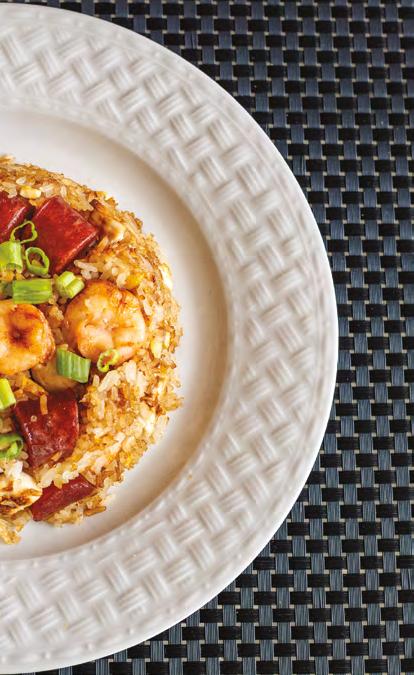
And while for many people in the local Vietnamese community, the Lunar New Year might be marked by fireworks, concerts, dragon dances and carnival games like those found at the annual Mary Queen of Vietnam Church celebration in New Orleans East, for the Finch family, it’s all about — what else? — delicious food and plenty of family bonding time.
“We always get together. I have two sisters who live in the United States, too, so for the Vietnamese New Year, we sometimes get together, even though we live so far away,” explains Jeannie. “When we get together, we cook all kinds of Vietnamese food, and everybody cooks together. My sisters are good cooks, too!”
“We have a really big family and every body’s very close. Even though everyone lives far away, when we all get together, it’s like there was no time between the last time we saw each other,” says Peyton. “I have this very vivid memory of her sisters coming over when I was very young and showing me how to roll egg rolls for the first time. It was a super cool experience, because I remember I was the only grandkid that was home, so it felt really special that I got to be a part of that.”
Spring rolls and egg rolls are also a family favorite around the holidays, and are easy to personalize with fish, shrimp, chicken, pork and, of course, plenty of fresh
Peyton is also working to keep her grand mother’s kitchen traditions and spirit of generosity alive and well by learning exactly what makes Jeannie’s dishes so magical. “I love to share my cooking with other people, and I think that’s something I inherited from her. I just started learning how to make pho over this past year, so sometimes I’ll call her and be like, ‘What do you put in this?’ or ‘I need help with this.’ And she’s always willing to teach me or send me different ingredients. I’m starting to learn everything that I know from her.”
And if food is a love language for Jeannie, it’s clear that it’s becoming one for her grand daughter, too.
“My mom’s side of the family, the food is American style, but over here it’s mostly Vietnamese food. It’s like two different kinds of Christmas,” Peyton says. “The first one is mashed potatoes, gravy, turkey, macaroni — all that. And then I come here, with Maw
 THE COLORS OF LUNAR NY ARROW-CIRCLE-RIGHT Red and yellow, or gold, are popular colors during the Lunar New Year festivities because they are believed to bring luck, happiness, wealth and prosperity.
PHOTOS BY JEANNIE DIMITRI SHUMAN
THE COLORS OF LUNAR NY ARROW-CIRCLE-RIGHT Red and yellow, or gold, are popular colors during the Lunar New Year festivities because they are believed to bring luck, happiness, wealth and prosperity.
PHOTOS BY JEANNIE DIMITRI SHUMAN


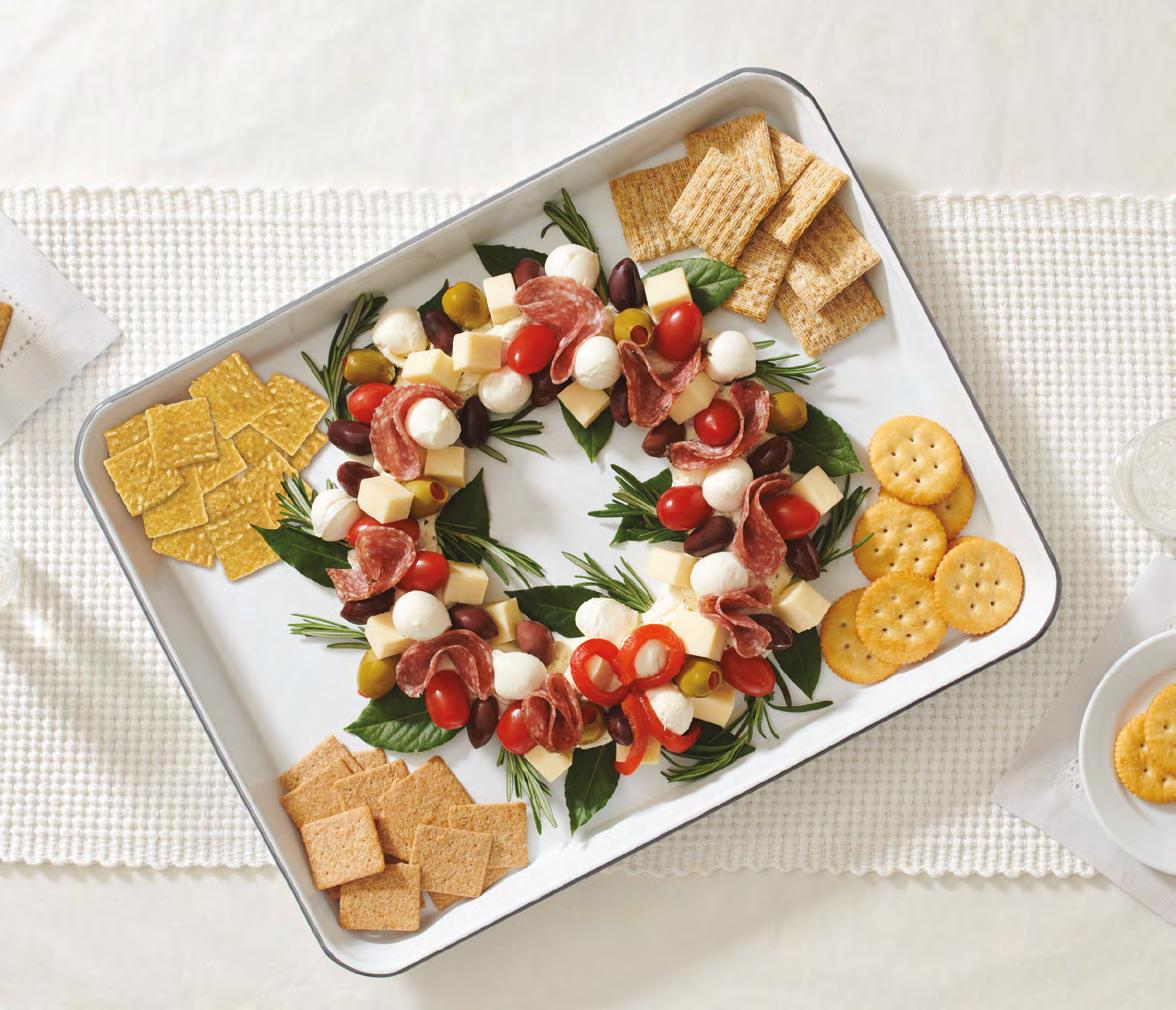









“I didn’t want to write an ego book, or be just the next bar to release a bar book,” says Neal Bodenheimer, co-founder of several New Orleans bars and restaurants, including Cure and Val’s (both on Freret St.), and Cane & Table and Peychaud’s (both in the French Quarter).

But he did write a book: Cure: New Orleans Drinks and How to Mix ‘Em, co-authored with Emily Timberlake. It was published this fall, with the title borrowed from Bodenheimer’s flagship bar, which opened in 2009 and won the James Beard award for the nation’s outstanding bar program in 2018.
His book is a wide-ranging journey through two parallel histories — those of New Orleans’ relationship with cocktails and the history of the craft cocktail movement over the last two decades.


Bodenheimer studied history in college, and he felt it important that this book reflect the city’s long and fabled links with liquor, as well as provide context for the more modern cocktail culture. (The subtitle is a riff on Stanley Clisby Arthur’s 1938 Famous New Orleans Drinks and How to Mix ‘Em.) Along with recipes from more than decade of cocktail creativity at his bars, it features brief essays on drinks that played key roles in New Orleans history, such as the mint julep and the Ojen cocktail. And he gives a nod to many of the city’s historic bars, such as the Carousel Lounge, Arnaud’s, and Tujague’s.
His book is equally about the cocktail revival that began in the early 2000s. It was a national renaissance, but had special resonance in New Orleans, where a good drink had never been wholly displaced by light beer or white wine spritzers. “We are preservationists,” Bodenheimer says. “People here were still making classic cocktails.”
Bodenheimer himself has deep roots in New Orleans — his forebears came to New Orleans around 1900. He left New Orleans for about a decade — college in Texas, followed by a New York City stint working in bars and restaurants. After Hurricane Katrina, he resolved to return home and be part of the rebuilding.
Once home, he discovered that a handful of folks around town were already mining the past when it came to cocktails: Paul Gustings at Tujague’s, Chris McMillian at the Library Bar at the Ritz Carlton, Chris Hannah at Arnaud’s, Danny Valdez and Ricky Gomez at Commander’s Palace. … There was a lot of good energy — Marvin
He partnered with childhood friend Matt Kohnke with the idea of opening their own bar. They stumbled upon a former firehouse that had most recently been an electrician’s shop on Freret St. “It was a dump,” he says, and at the time the rundown street didn’t seem the most promising spot for a high-end cocktail bar. But the pair took the chance, bought the building, and started tearing it up, returning it to the basics. “In New Orleans, it’s all addition by subtraction,” he says.
In 2017, he took another step to preserve and expand New Orleans cocktail culture when he partnered with the Solomon family to acquire Tales of the Cocktail, an annual, international convention of craft bartenders, liquor companies, and other cocktail experts. “It’s one of those events that has really helped create a love for New Orleans from people around the world,” he says.
Much the same might be said of his new book. Visit curenola.com/book to order a copy of Cure: New Orleans Drinks and How to Mix ‘Em, or visit Cure on Freret Street and pick up a copy. Also available in bookstores.
Allen was doing his thing at the Carousel Bar, and Alan Walter was doing a lot at Iris. It was fertile.”reflected in recipes passed through the generations, like white bean and potato soup, and keks, a fried bread sweet treat.

When he came upon his grandmother’s box of handwritten recipes after her death, Jarred became consumed with a passion to share his family’s German Cajun stories and dishes with the world. The resulting cookbook, Southern and Smoked, Cajun Cooking Through the Seasons provides a glimpse into the life of his hardworking forebearers who have lived, worked, and farmed along the Mississippi River for more than 300 years.
While exploring the area’s history at the Louisiana State Museum, Jarred happened upon a box of old silver negatives discovered in a River Parish attic in the 1980s. He realized that they were the work of his grandmother’s first cousin, Olide Schexnayder. A professional photographer working in the area between 1880 and 1910, Schexnayder’s subject matter was often his family. Garbed in the formal attire of the day, Jarred’s 19th-century relations are seen fishing on the bayou and picnicking, complete with sticks of Andouille laid out on a picnic blanket. In 1899, Schexnayder captured a gathering on the frozen riverbank in Edgard as ice floes pass on the Mississippi. These images provide an amazing link to the past.
When Jarred brought family and friends together to recreate the annual boucharie, held every February for generations, cousins produced pictures taken at the gathering in 1950. Those photographs included his grandparents, unmarried and on their way to a date in Donaldsonville.

ARROW-CIRCLE-RIGHT For forty years, Tony Mandina’s Restaurant in Gretna has been known for its homestyle hospitality and unbeatable red gravy. Everyone who walks through the front door is greeted like family, because for the Mandinas, their customers are family. That is how it’s been since 1982 when, with his own two hands, Tony transformed a derelict BBQ shack into a proper restaurant. Originally intending to offer the building for lease, Tony convinced his devoted wife Grace to open their own restaurant there once construction was completed.
No one in the family had any prior experience in the food business, but through trial and error and lots of hard work, Tony Mandina’s Restaurant became a Westbank institution. From freshly baked bread to meatballs with red gravy to cannoli, Tony replicated his mother’s authentic Sicilian recipes. That red gravy, made according to Mawmaw Mandina’s exacting instructions, has always been the backbone of Tony Mandina’s menu. In 2014, it became a popular grocery store item when it was made available in jars for home cooks.
Jarred Zeringue, born and raised in Vacherie, grew up believing he was German. The Zeringue family settled in the River Parishes in 1720, arriving directly from Alsace, a very Germanic region of France. Their heritage was
The book is divided seasonally as Jarred explained, “Exploring each season through recipes makes them more costeffective,” an encouragement to readers to eat local produce, and preserve seasonal dishes through canning or freezing. Southern and Smoked is a fitting tribute to Jarred’s Louisiana heritage and one you will be glad to share.
Through the generations the Mandinas maintained ties with family in Palermo. Their daughter, Kolette Mandina Ditta, dug deeper into their family roots in Sicily and discovered long-lost cousins in Salaparuta. This branch of the family crafted olive oil and wines from ancestral groves and vineyards in the Sicilian hill country, and Kolette began an import business to bring these special products to the United States. When Kolette and her daughter Lindsey purchased the business from the family in 2020, Tony and Grace retired to the restaurant’s “Table 41,” where they still greet guests daily.

The fall after she took over Tony Mandina’s, Kolette reached out to me with an idea for a cookbook. Once I met the family and heard their wonderful story, I knew this was a unique hometown tale that deserved to be told. Tony Mandina’s Kitchen generously shares both the family’s charming history and the delicious recipes that have made the restaurant a Gretna landmark.
Authentic, unusual Sicilian delicacies like cassatedde, a sweet filled pastry; ‘nfigghiulata, a savory filled pastry; and sfince di patate, or potato donuts, courtesy of the Salaparuta cousins, are also included in the collection.
Tony Mandina’s Kitchen can be ordered at www.tonymandinas.com, and visitors can purchase autographed copies at the restaurant.
— Poppy TookerARROW-CIRCLE-RIGHT I had the good fortune to grow up in the Sicilian community in New Orleans. I watched as the original immigrants died off and the next generation spread around the city and beyond. It was wonderful to experience the people who left their homes and culture and had an influence on their new home. But my experience of being a part of this special community cannot be passed on to my children and grandchildren, because the people who made it special are no longer with us.
I grew up with the sounds of the Sicilian language being spoken at parties and other gatherings. I heard folk songs sung as others played the mandolin or the concertina, and even the occasional
violin. And I ate the food made by skilled hands and with lots of love. I had my cheeks pinched by professionals. And I danced with people of all ages as we celebrated the culture.
As my grandchildren have gotten older, I have tried to explain this waning Sicilian culture to them. But they have no lived evidence of it. I speak English. We don’t go to gatherings where the songs and dancing are spontaneous. Today those events are staged and rehearsed. They are a memorial to the past, but not the living past. So, I did two things: I looked for first-person accounts of living in New Orleans written by Sicilian immigrants, and I engaged in cooking therapy by making the foods I ate and loved growing up.
I couldn’t find first-person accounts of Sicilian life in New Orleans from the 1950’s on. There are histories of businesses, newspaper accounts of various events in the Sicilian community, and just the historic record of the impact of the Sicilians. But these are third-person accounts. I wanted to find firsthand records. So, while I still could, and encouraged by the memories jogged by all the food I was cooking and eating, I decided that I would write my own firstperson account of this Sicilian immigrant community, which was already waning as I grew up.

I had never written a cookbook before, and I was daunted because it required measuring. (I am a “throw in a handful of this and a slurp of that” kind of cook.) But finally, with memories illustrated by recipes, and with lots of help and encouragement of a good editor, I had a book finished. We finished the book with a few old photos, and I had something to give to my children to pass on my story, their heritage, and the food that we ate along the way.
As I give book talks, people tell me their immigrant and children-of-immigrant stories. I am gratified that the immigrant story is universal, and the subsequent generations gradually meld into all of America. I dedicated the book to my two children and my two grandchildren. But
I also feel that I wrote the book to honor those people who were unafraid to forge a new life in America.
— Liz Williams
ARROW-CIRCLE-RIGHT Mason Hereford has been causing quite a stir in New Orleans since he opened the unassuming Uptown sandwich shop, Turkey and The Wolf, in August 2016. When it was proclaimed “America’s Best New Restaurant” by Bon Appetite Magazine a year later, heads everywhere turned. No one was more surprised by the acclaim than Hereford himself, who is both owner and chef. Praise and success followed Hereford when his second restaurant, popular breakfast spot Molly’s Rise and Shine, opened in late 2018.
When the announcement came that Hereford was writing a book, it quickly became one of the most anticipated cookbook titles of 2022. But in early spring, a large wave swell and winds of 22 knots caused the container of printed books to slip overboard near the Azores, ending up on the bottom of the Atlantic Ocean instead of bookstore shelves. The disaster turned into a boon for Hereford, later, when The New York Times bestselling author Melissa Clark discovered that her latest cookbook, Dinner In One, was in the same container. The resulting coverage turned Turkey and The Wolf, Flavor Tripping in New Orleans into a bestseller long before it finally hit bookstore shelves in June.
It is safe to say you may never have seen a cookbook quite like it. From Gas Station Tostadas flavored with “Dorito
NANA’S CREOLE ITALIAN TABLEDust,” a crumbled mix of Nacho Cheese and Cool Ranch chips, to the Grand Slam McMuffin, a Molly’s Rise and Shine favorite that Hereford describes “as American as gluttony and cease-anddesist letters,” nothing is held back.
The Bologna, which is Turkey and The Wolf’s most celebrated sandwich, is included in its full glory. Hereford credits his sourcing butcher shop, Piece of Meat, for the company’s “artisan tubed meat,” while giving full instructions on how to make the “quick pickled” homemade chips and Tay’s Sweet Hot Mustard at home—both essential to the finished dish.
With all the fun to be found within its pages, there is also a lot of serious culinary knowledge. Hereford walks readers through the arduous process of making hog’s head cheese, complete with a two-page itinerary to help “get it done in one day.” Adventurous cooks are rewarded with recipes utilizing hog’s head cheese in rice, tacos and collard greens. This cookbook is the perfect gift for all flavor trippers and thrill seekers on your holiday list.
— Poppy TookerARROW-CIRCLE-RIGHT Pascal’s Manale restaurant has been an Uptown New Orleans institution since founder Frank Manale opened the casual eatery on the corner of Napoleon Avenue and Dryades Street in 1913. Originally more of a bar than a restaurant, from its earliest days, oysters on the half shell and oyster loaves were part of the fare. Early on, Frank was known as a bootlegger and gambler who ran a bookie operation
in the back of his bar. But over time, Manale’s gained fame for its stellar Sicilian Creole cuisine.
Frank and his wife, Alice, did not have children of their own, but his nephews — Pascal, Pete, Jake, and namesake Frank — joined efforts to make their uncle’s place a success. In 1937, when Frank Manale died unexpectedly at age 57, the family came together to continue in his stead. Pete was a waiter and Jake cooked, with Frank and Pascal running the business from behind the bar. Eventually, Pascal assumed ownership and added his name to his Uncle Frank’s.
Pascal’s wife, Frances, and his unmarried sisters, Lulu and Mamie, played an integral role in the restaurant. Daily, from the kitchen of the large family home they shared on Louisiana Avenue Parkway, they prepared the restaurant’s red gravy and meatballs and stuffed Pascal’s famous artichokes. In 1954, Pascal created barbeque shrimp, forever making Manale’s a New Orleans culinary destination. After a fatal heart attack took Pascal in 1958, his siblings and his four offspring carried on the family restaurant tradition for the next forty years.
Sandy, Bob, Mark and Ginny DeFelice, Pascal’s grandchildren, ushered the restaurant into the 21st century, ensuring the family’s reputation for delicious food and warm hospitality was always paramount. There was never a time when a family member was not in attendance there. Pascal’s Manale was hailed as the second-oldest familyowned and -operated establishment in New Orleans, following 150-year-old Antoine’s, and in 2013 celebrated its centennial.
The DeFelice family gave me the honor of telling their remarkable Sicilian Creole family’s story in the 2018 book, Pascal’s Manale Cookbook. With the exception of barbeque shrimp, the book is complete with all the recipes that made the restaurant famous. In 2019, Manale’s was purchased by Ray and Jessica Brandt. Ray Brandt’s widow owns the business today.
 — Poppy Tooker
— Poppy Tooker
ARROW-CIRCLE-RIGHT Bring some Cajun into your kitchen with this keepsake cookbook from Jason Derouen, the online personality behind The Cajun Ninja. PI-YAHHHHH!! invites you into Jason’s home for meals tested and approved by his very own family. From springtime crawfish boils with all the fixins to fried turkey Thanksgiving feasts to everyday weeknight meals spent around the family supper table, these Bayouborn recipes are enough to make you say “PI-YAHHHHH!!” yourself. Available from https://www.hoffmanmediastore. com. Pick up a can of The Cajun Ninja’s PI-YAHHHHH Seasoning at any Rouses Market.

ARROW-CIRCLE-RIGHT Secrets of a Tastemaker: Al Copeland, The Cookbook, chronicles the fried chicken magnate’s life and the rise of the Popeyes fast food empire. The book, from Kit Wohl and Chris Rose with the Copeland Family and foreword by Al Copeland Jr., includes countless stories and over 100 recipes (though not those associated with Popeyes), including Buttermilk Biscuits, Sweet Heat Chicken, Ricochet Catfish, Fettuccine Lamborghini and Cajun Duckanoff.
